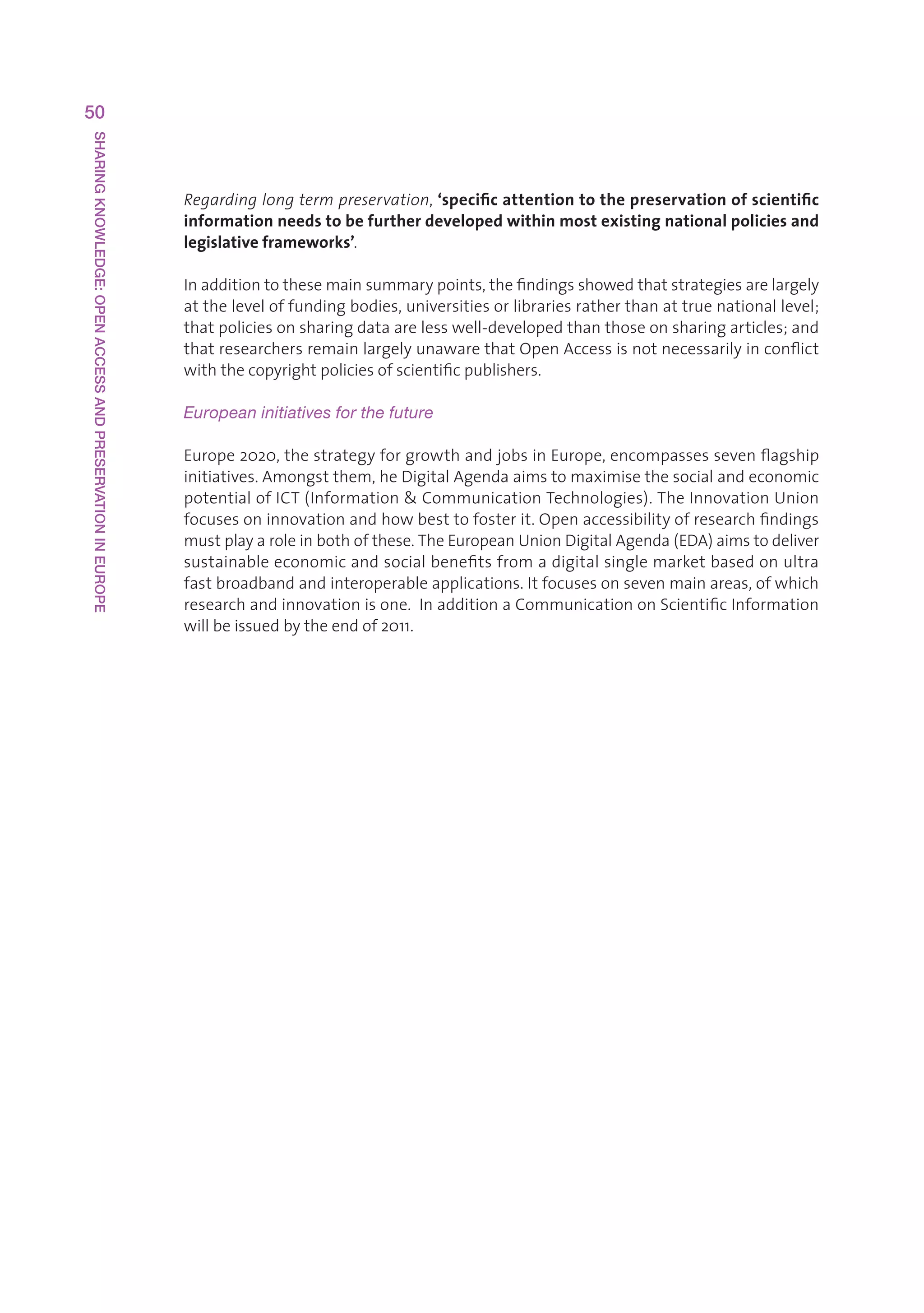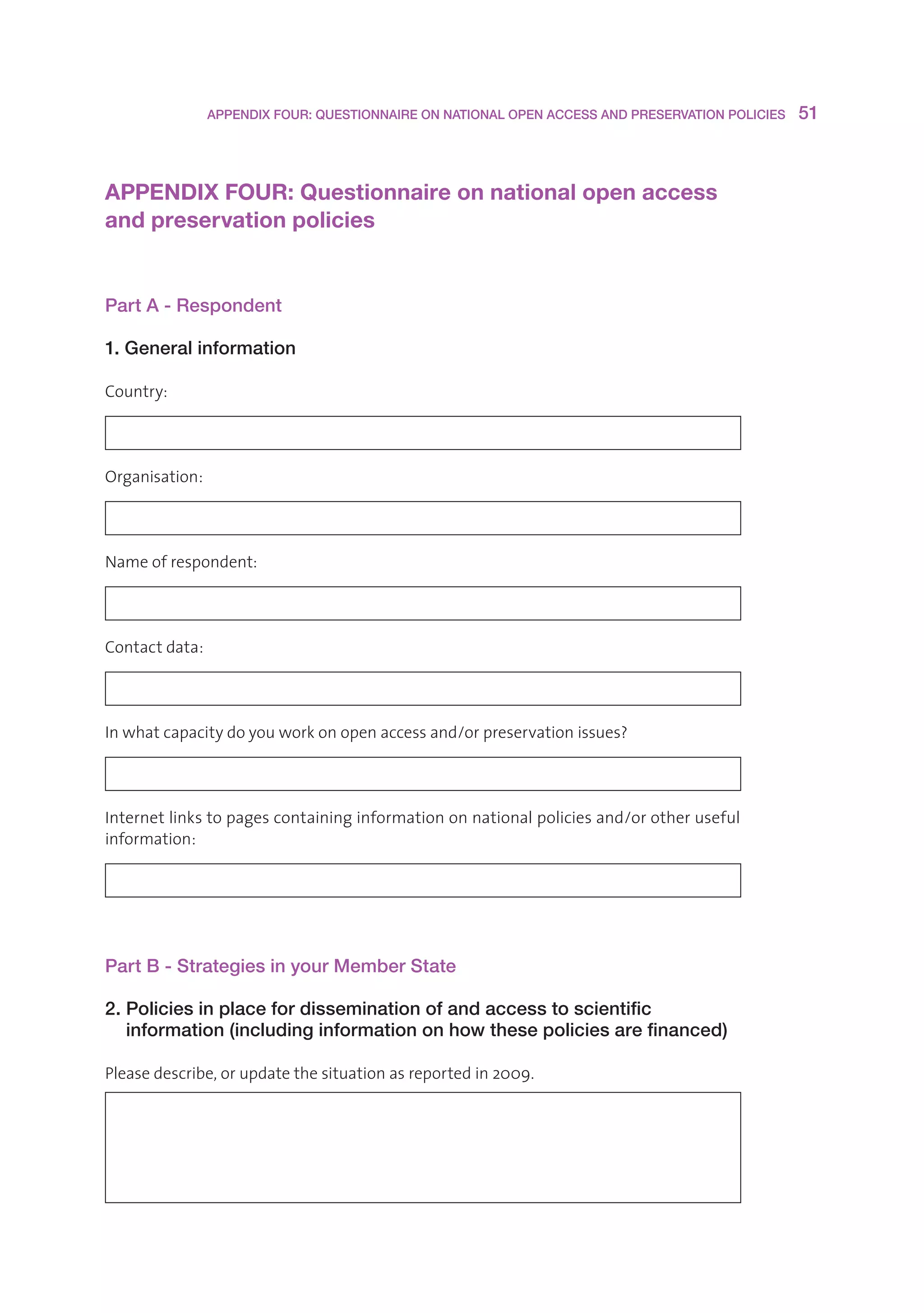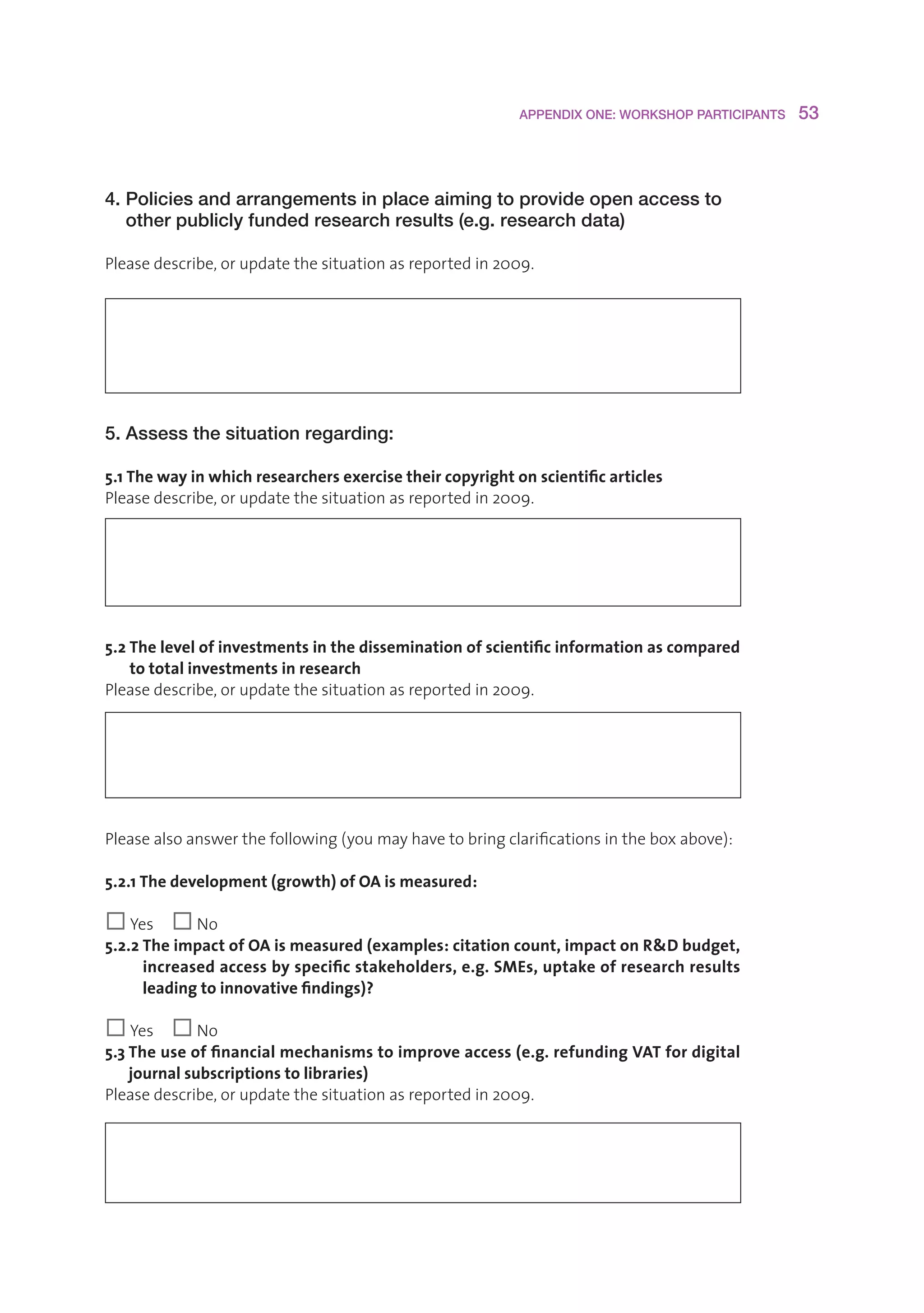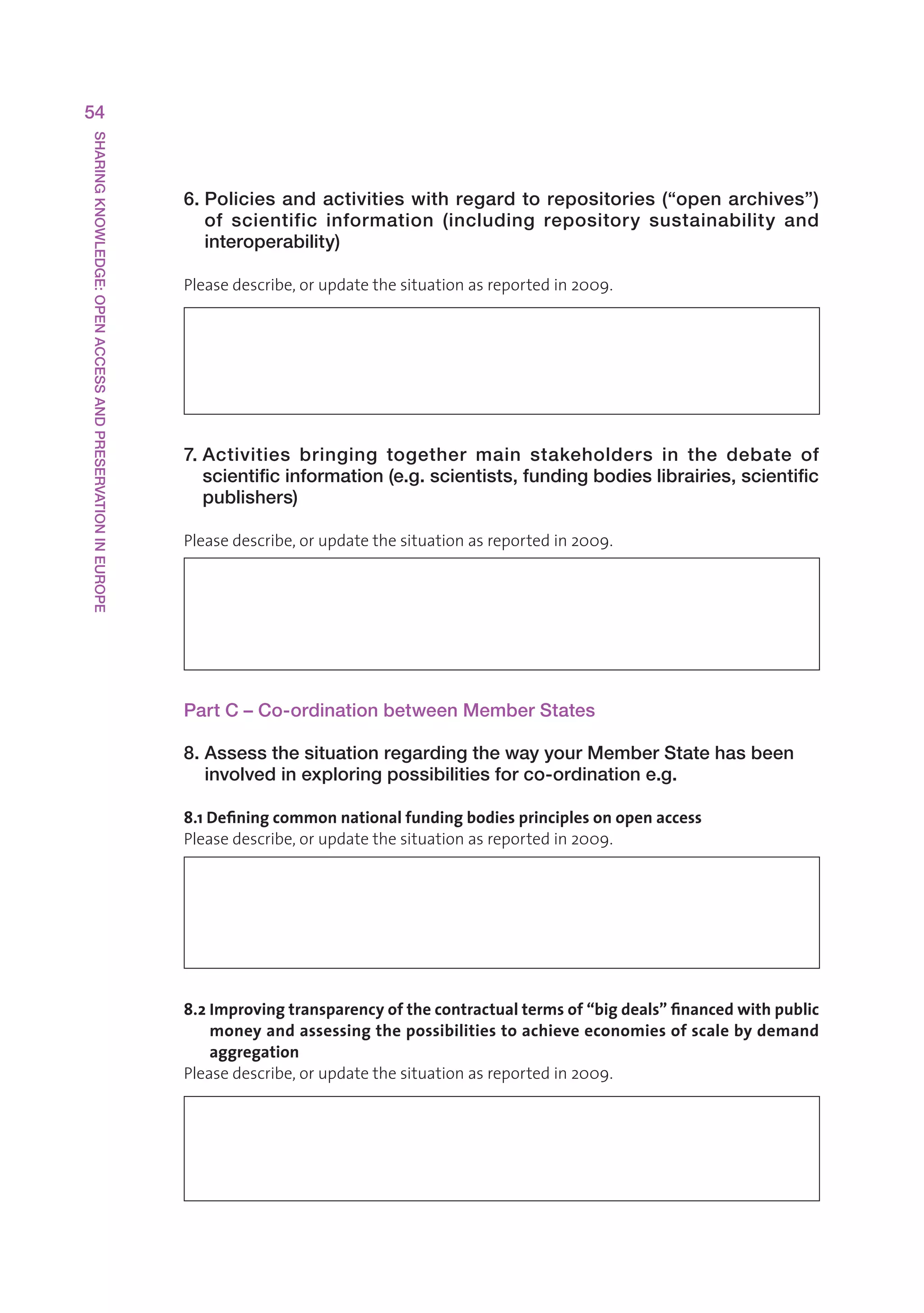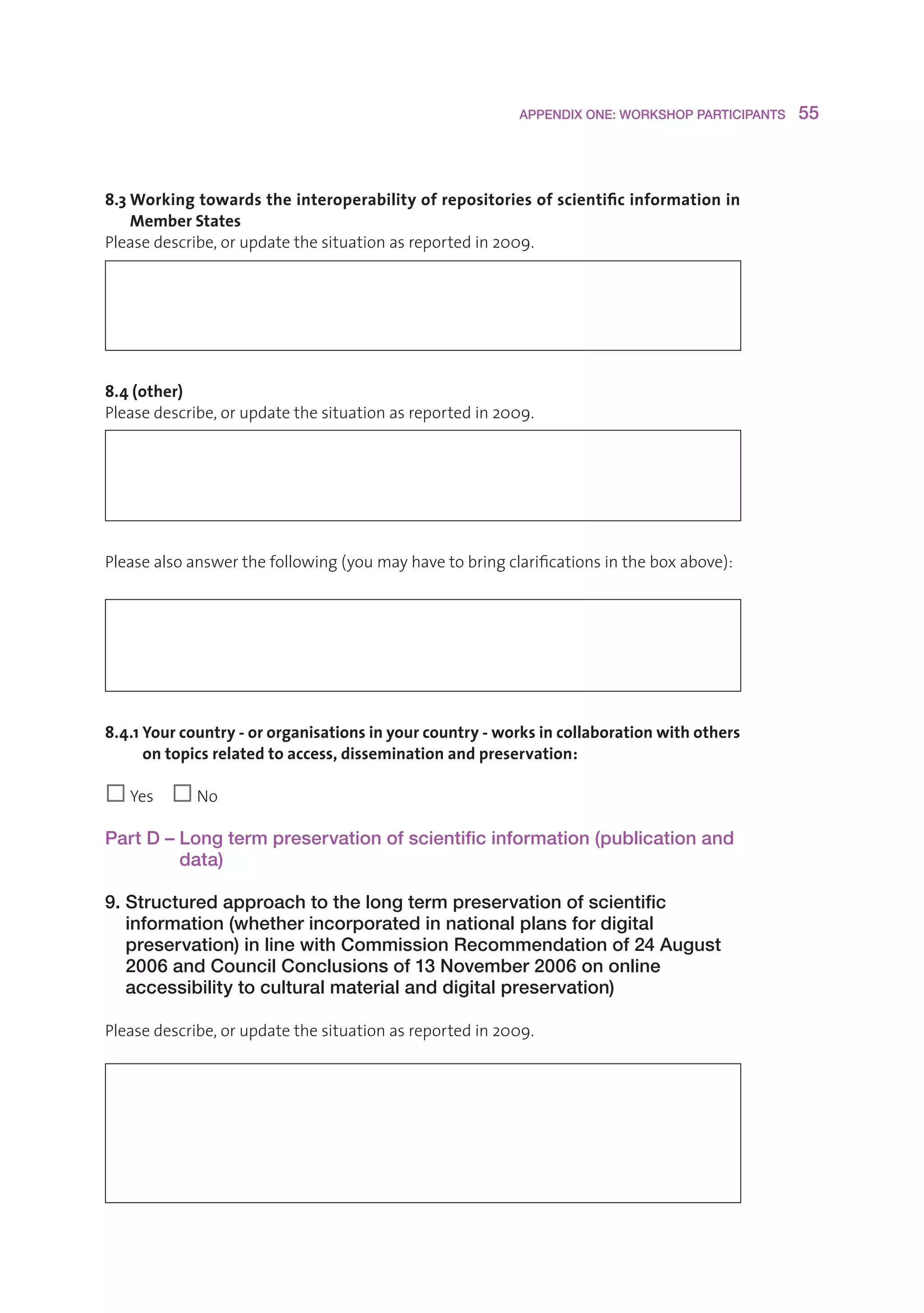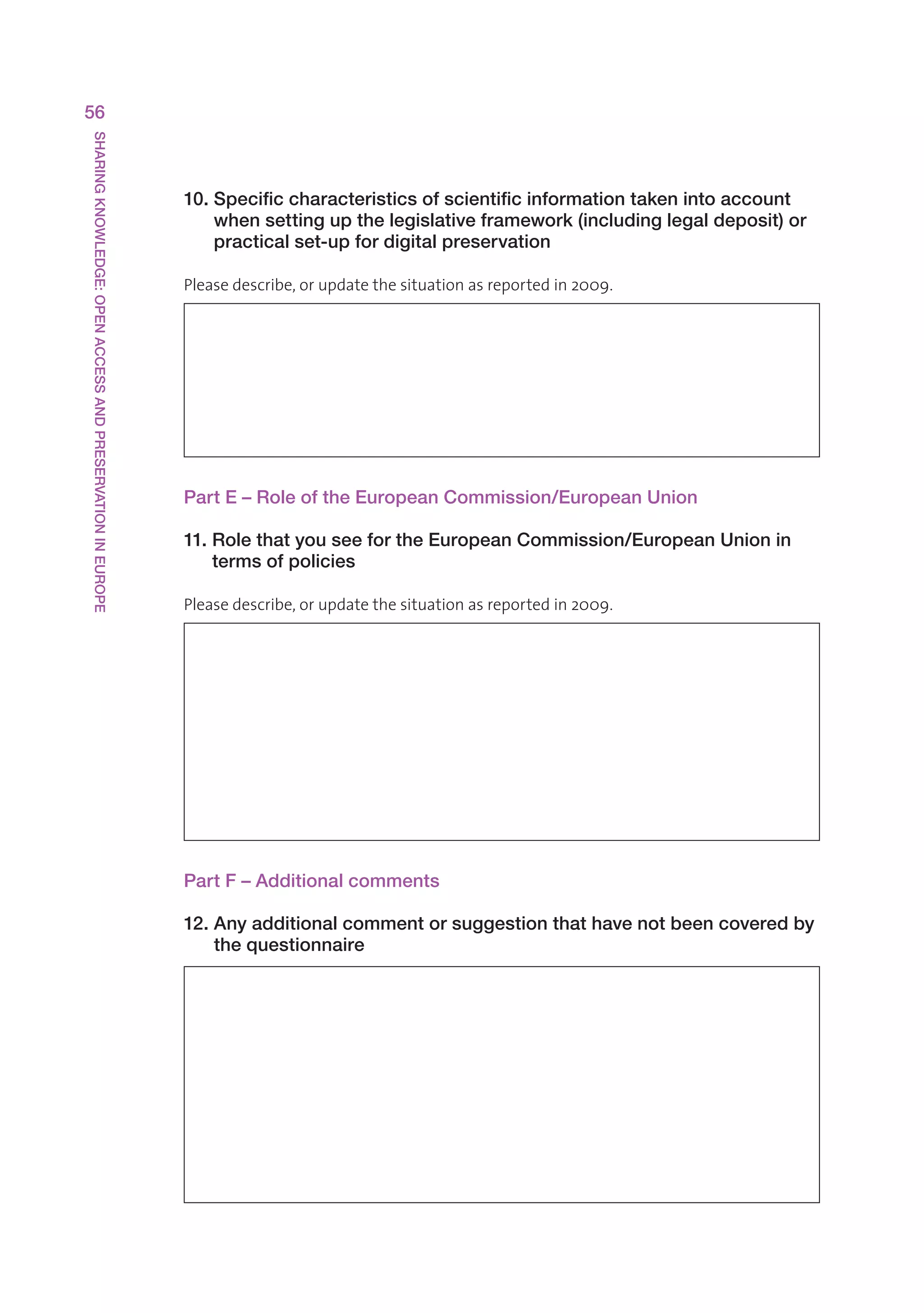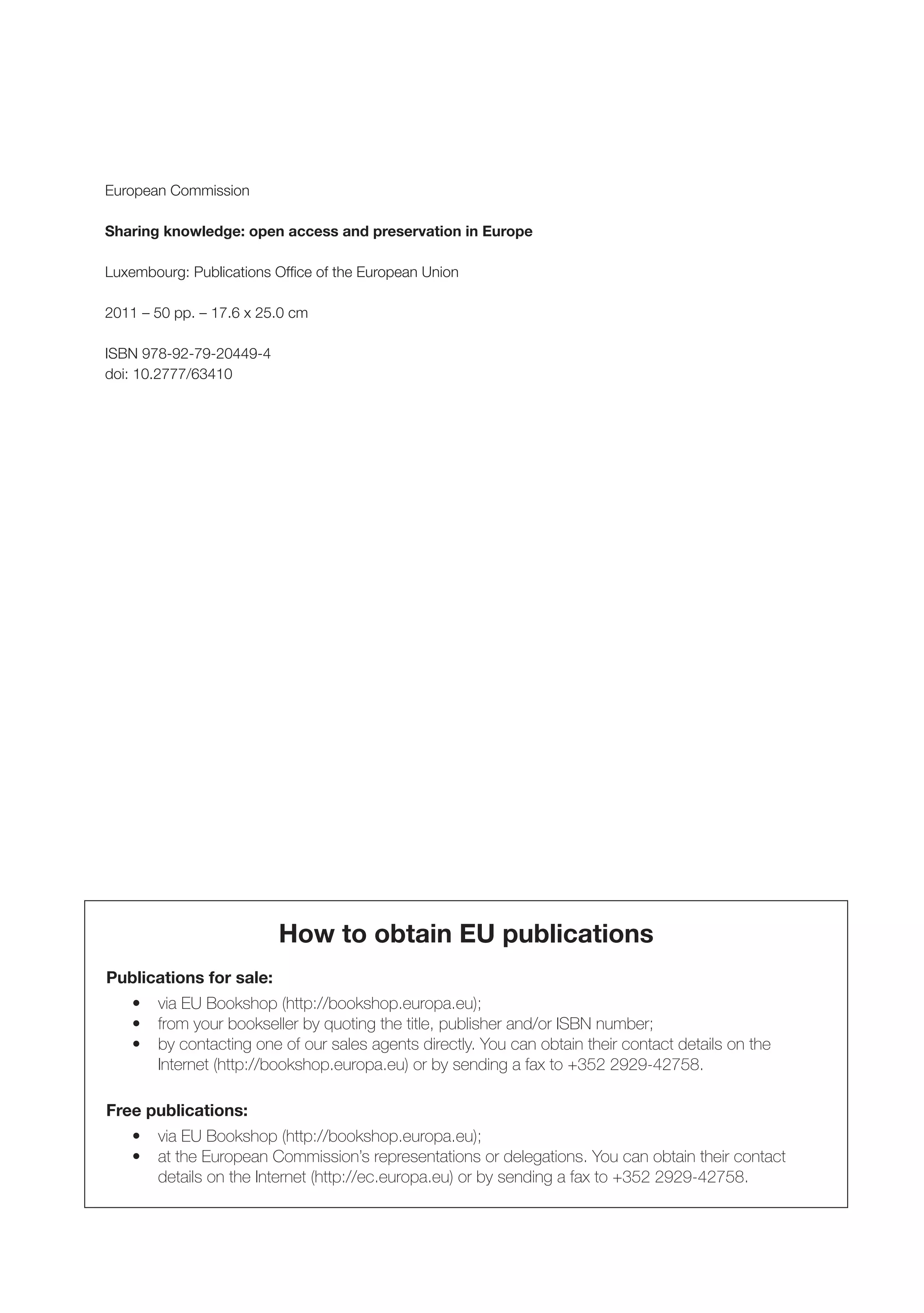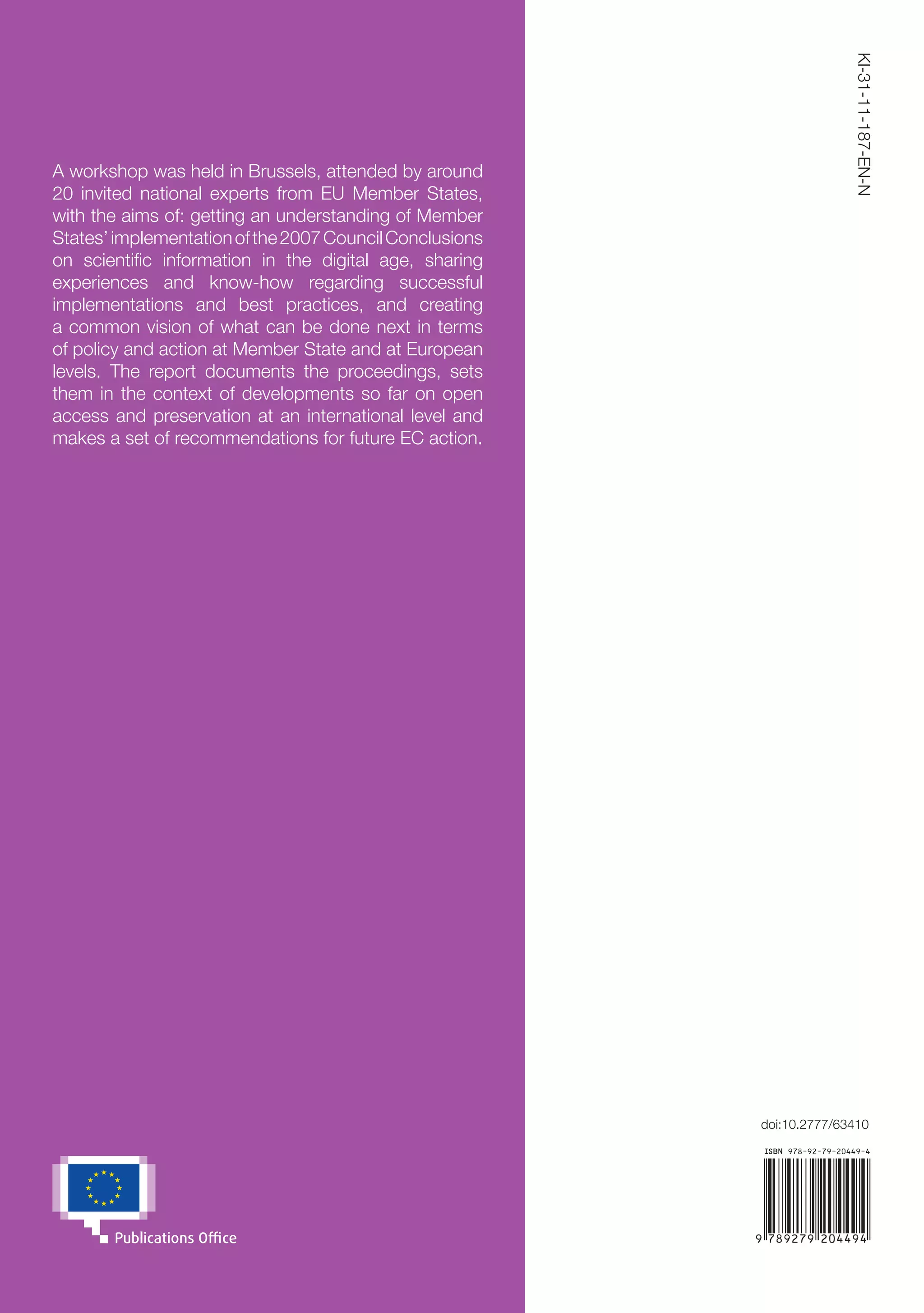The document presents the conclusions of a strategic workshop on open access and preservation in Europe held in Brussels on November 25-26, 2010, with participation from national experts across EU member states. It highlights the importance of open access, addresses challenges faced in its implementation, and suggests concrete actions and recommendations for enhancing open access policies and practices at both national and European levels. The report emphasizes the need for stakeholder engagement, policy development, collaboration, and infrastructure to promote the benefits of open access for research and society.
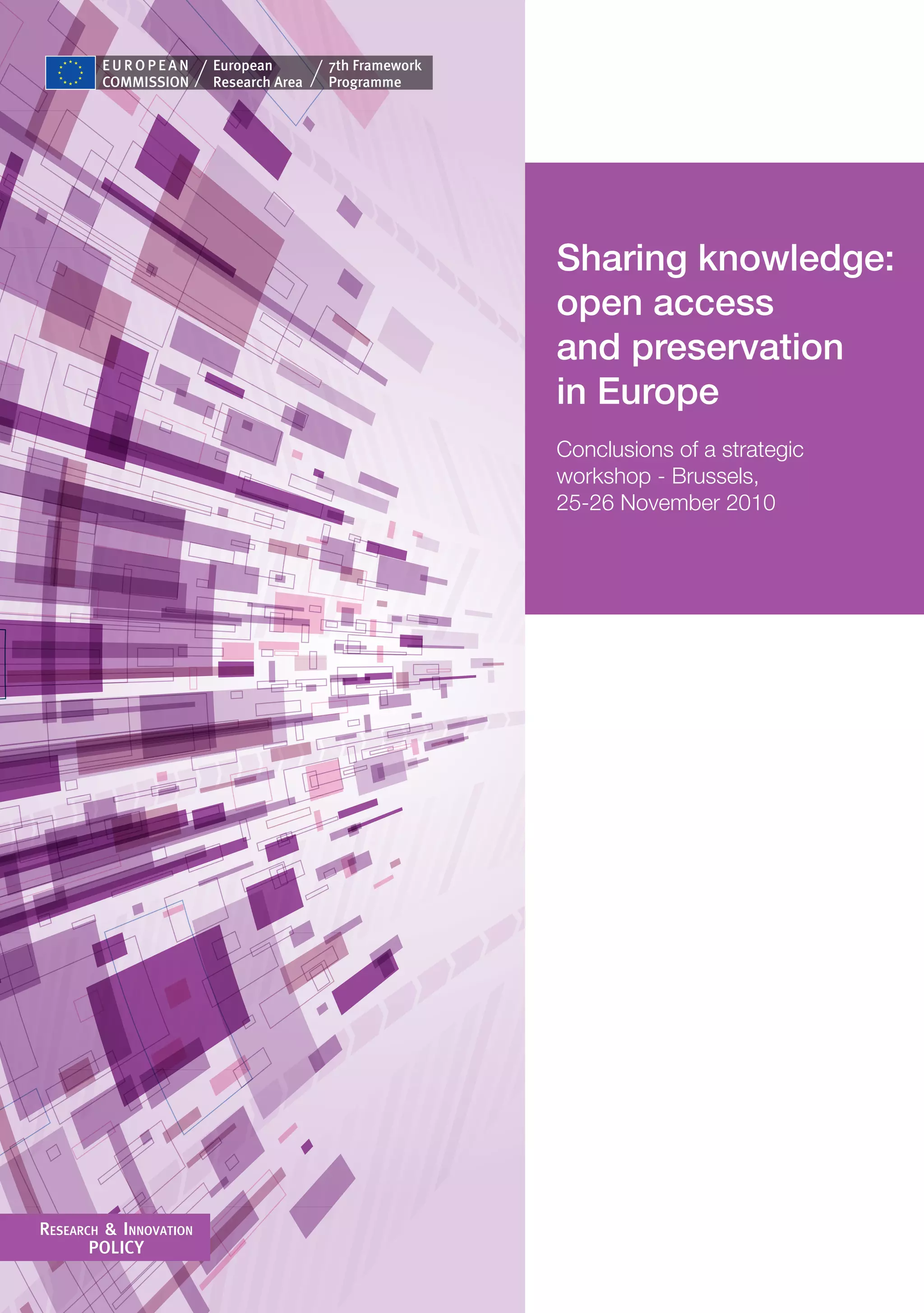
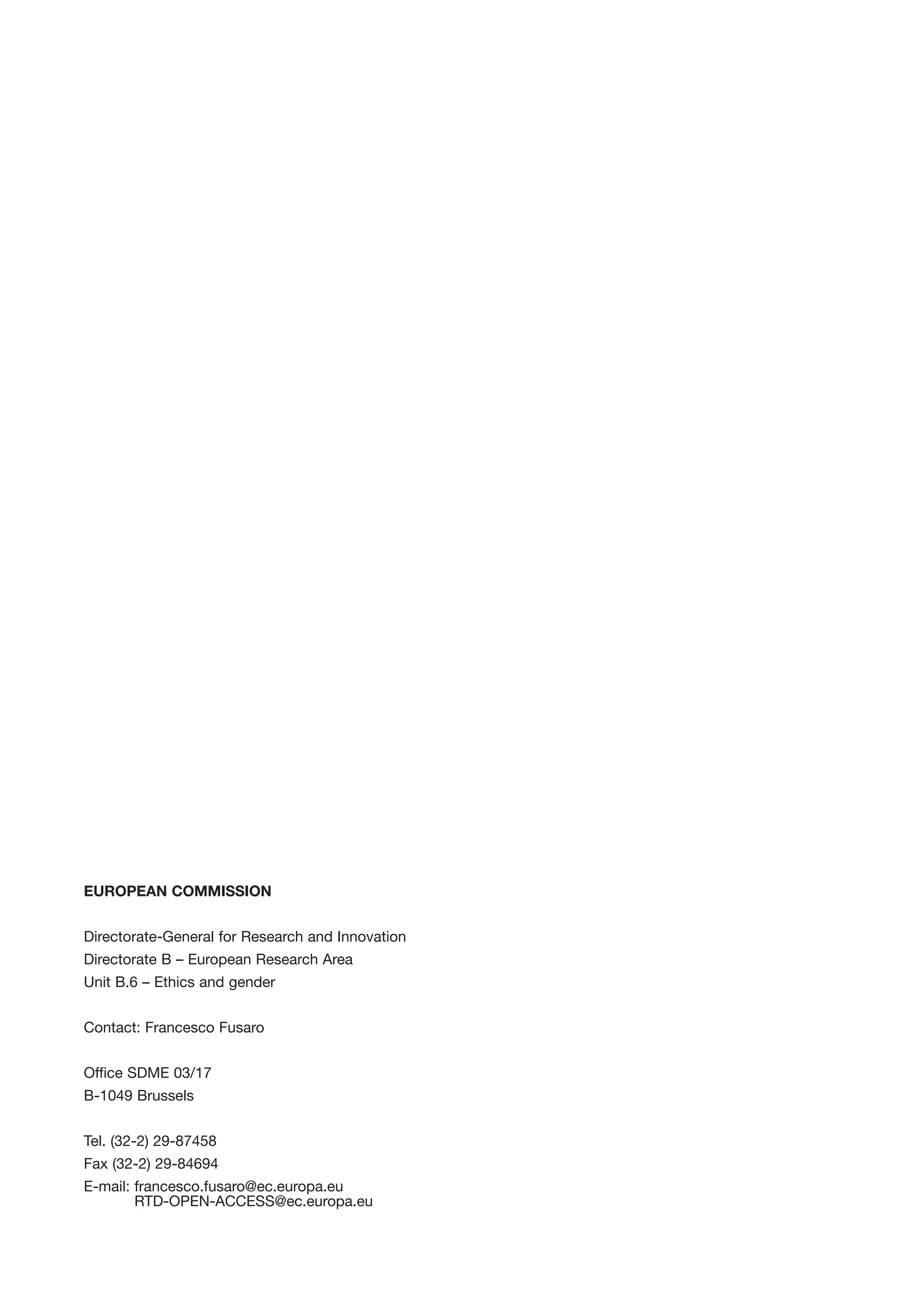
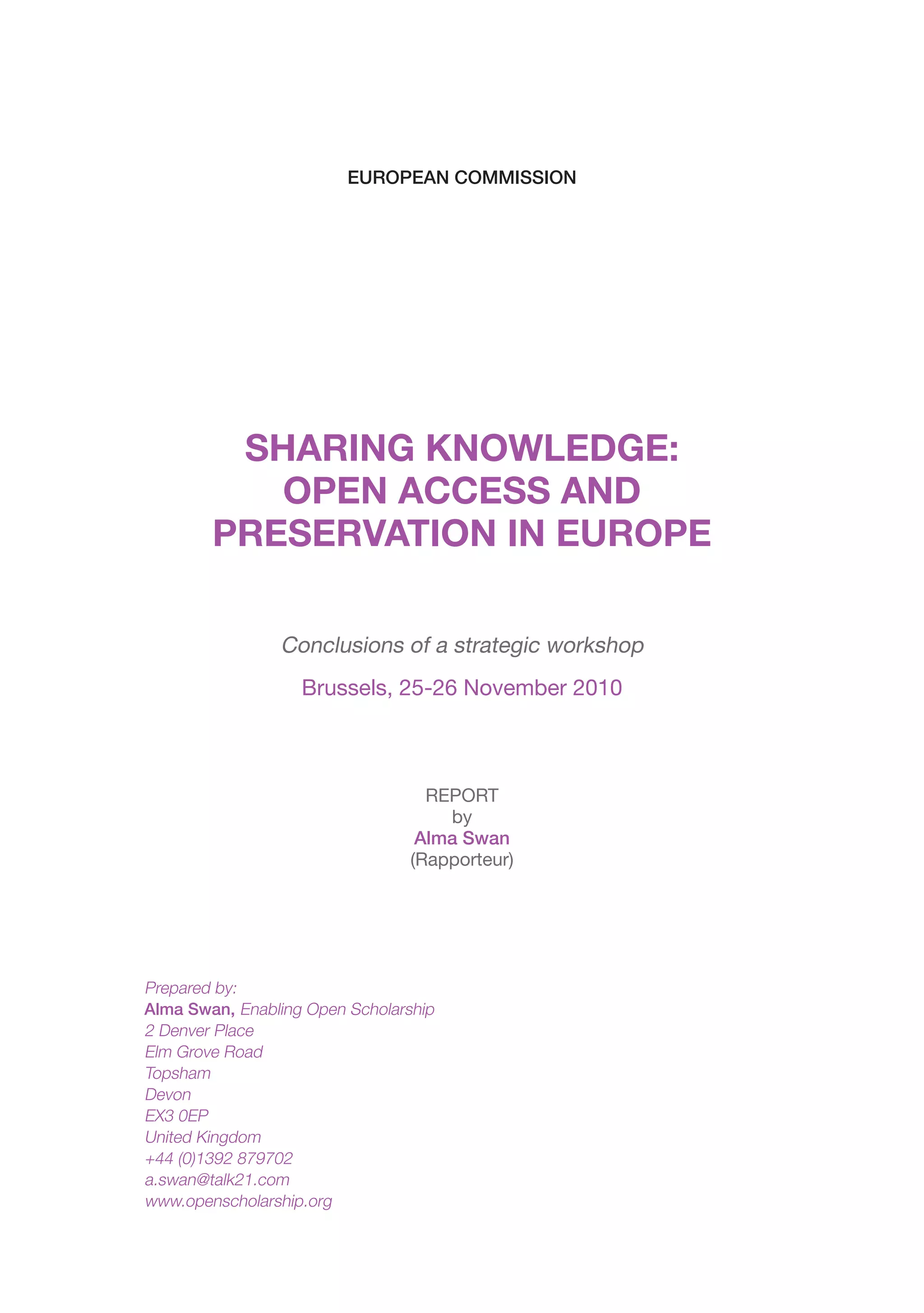
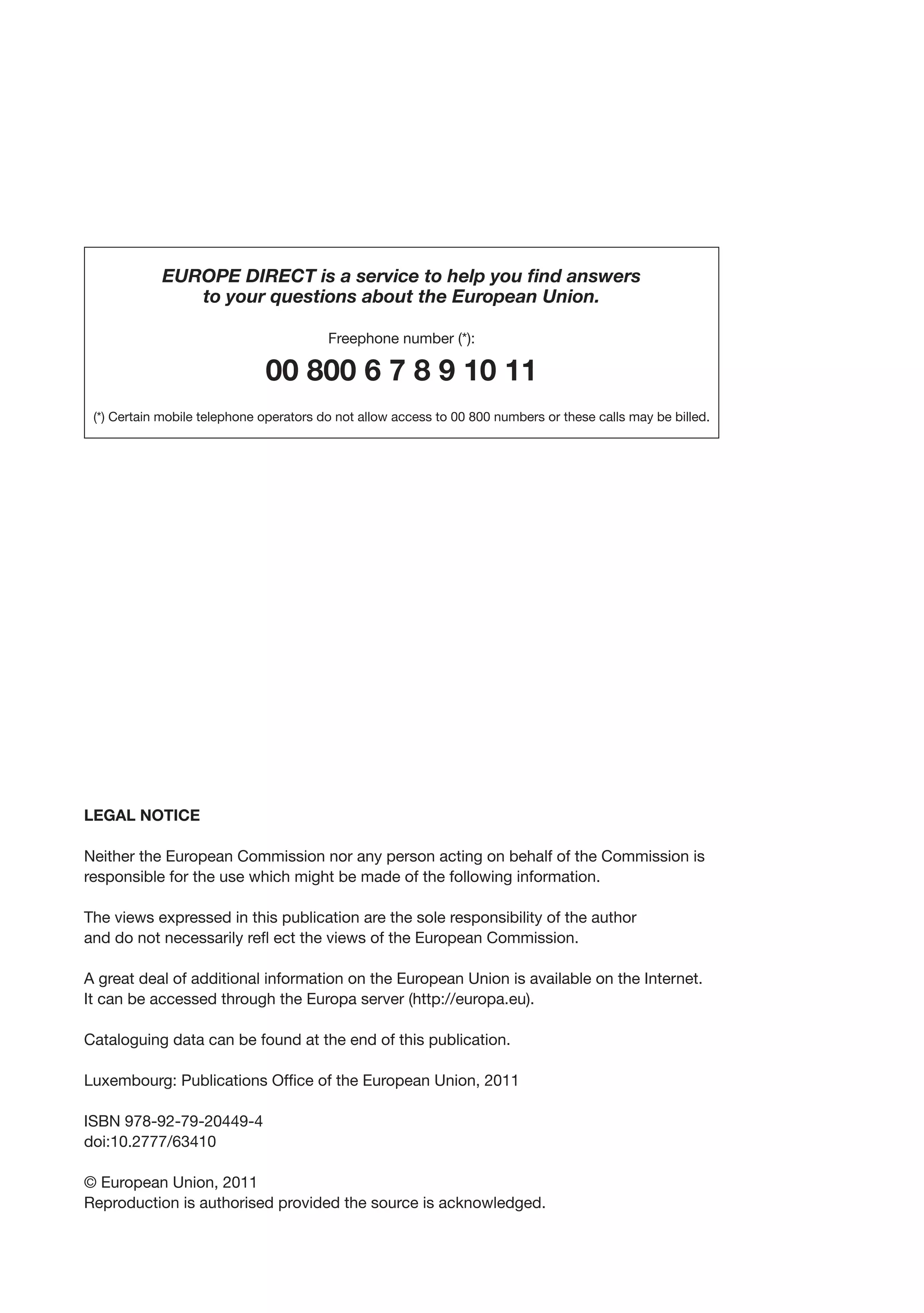
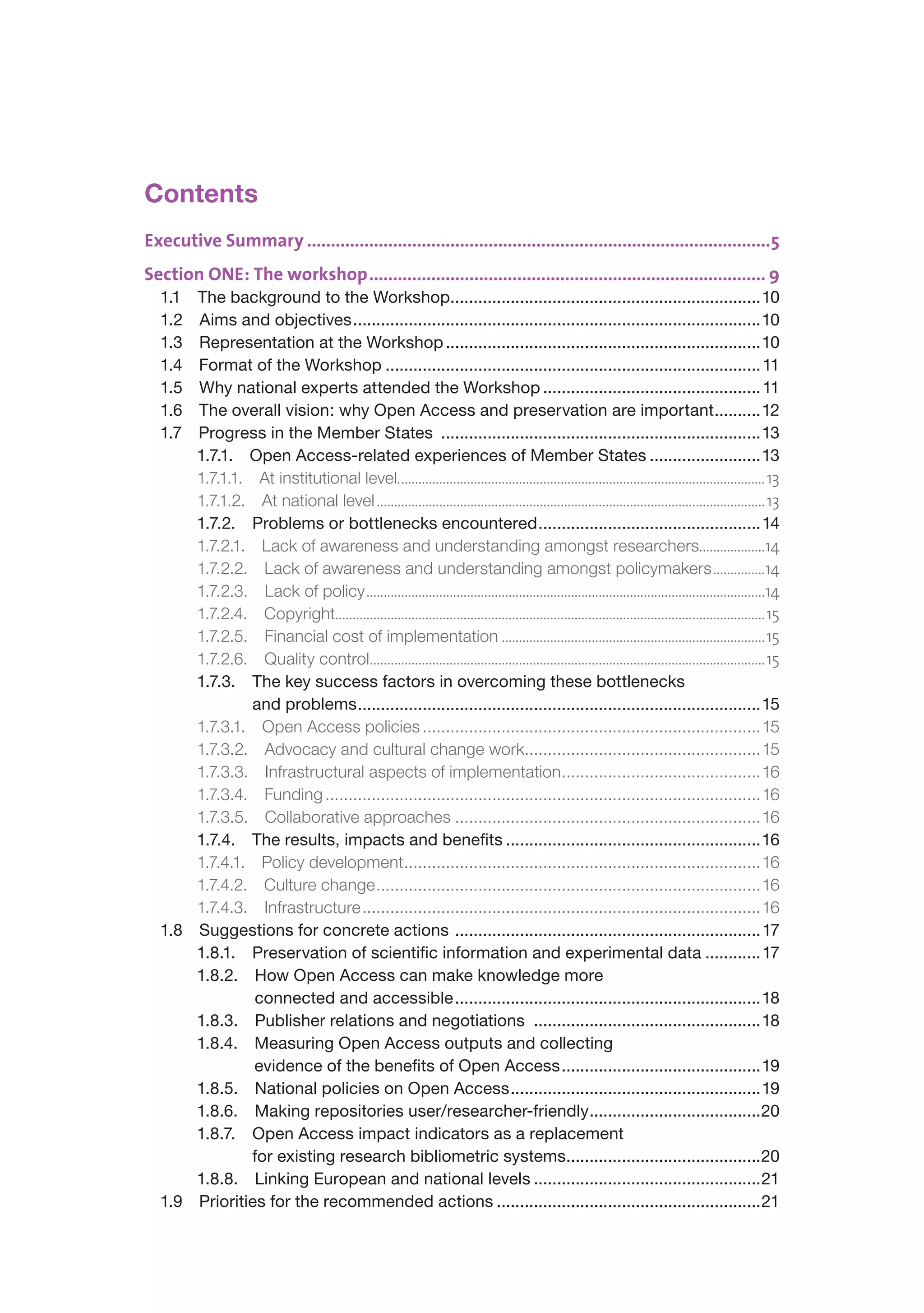
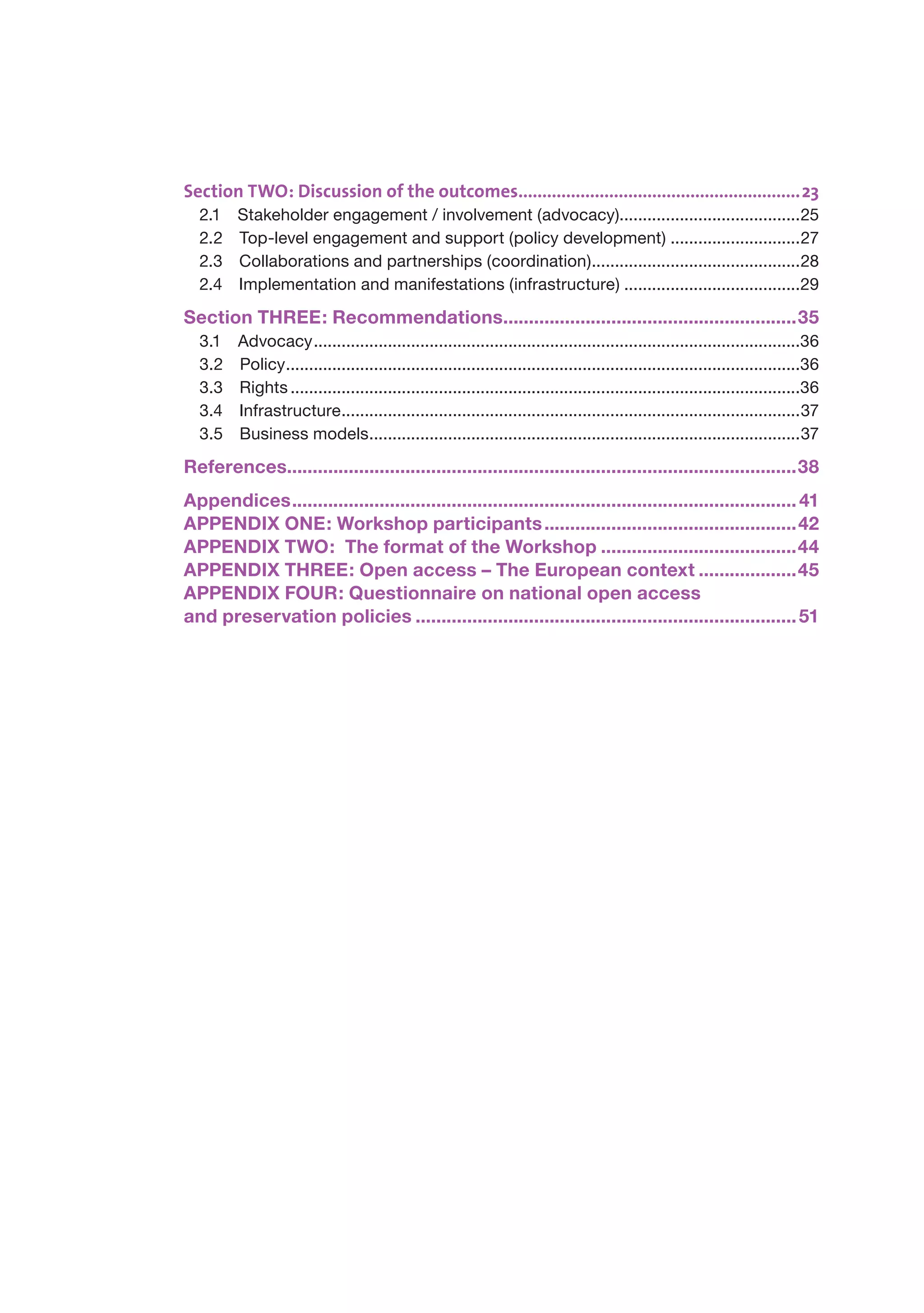

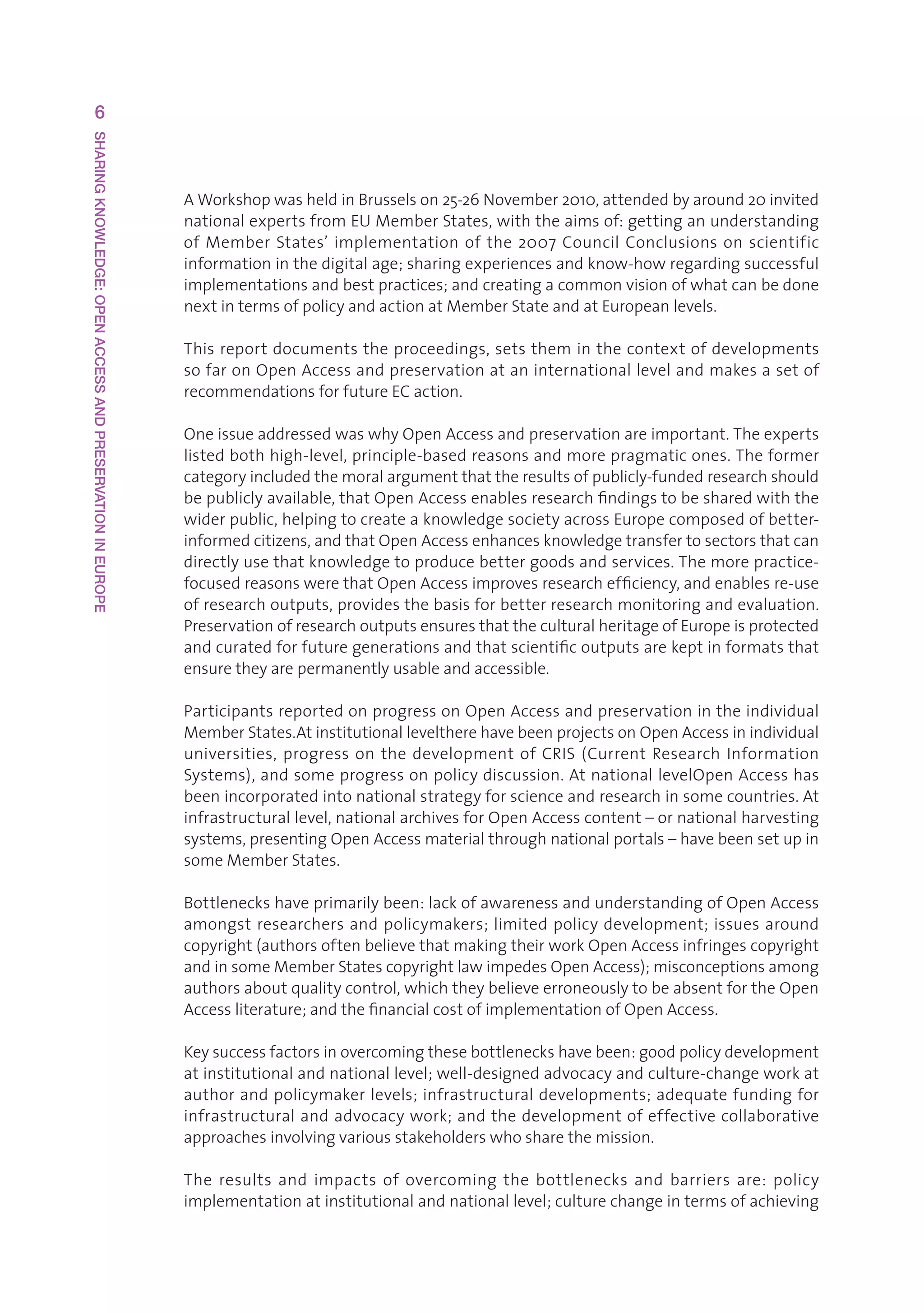
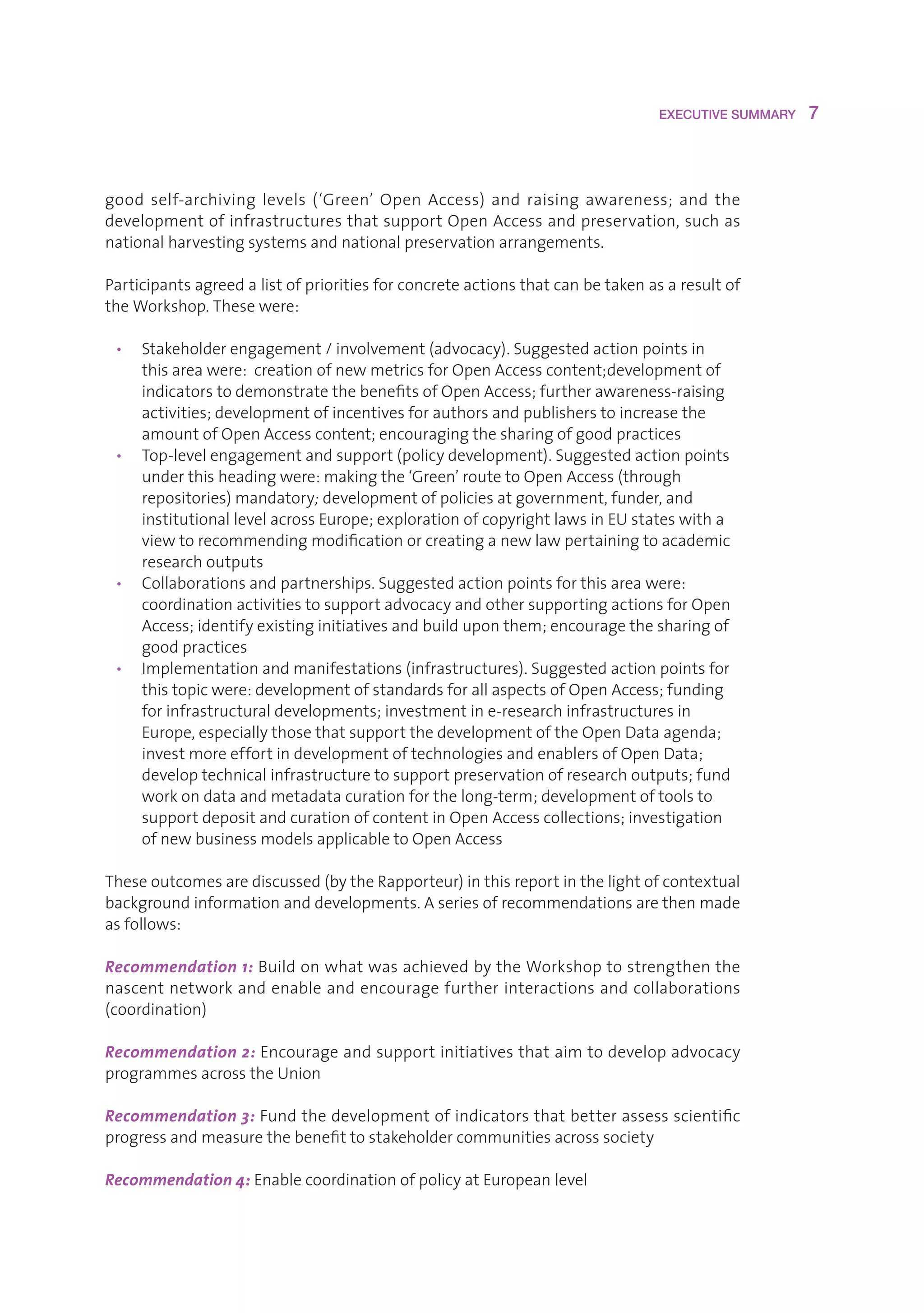
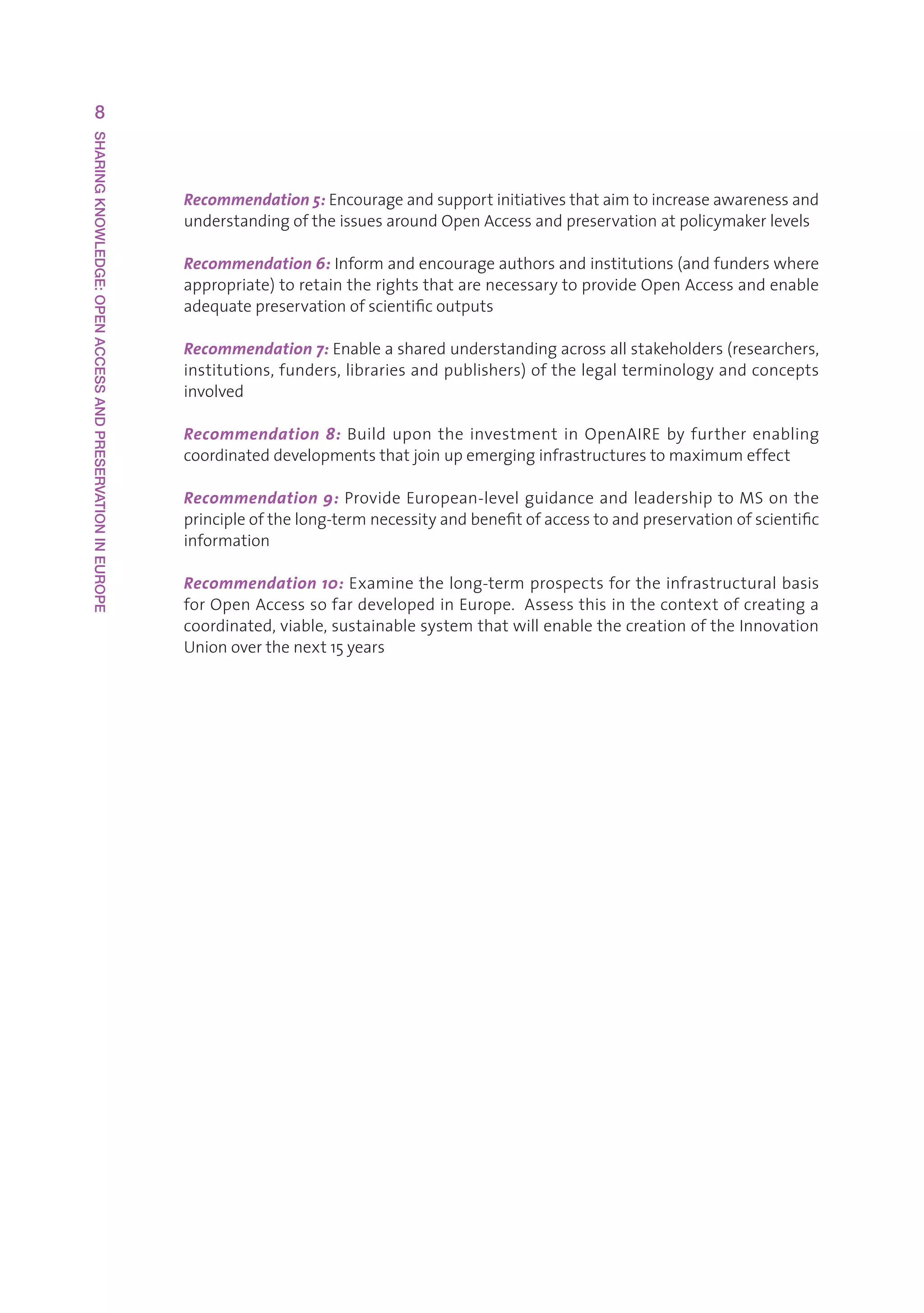

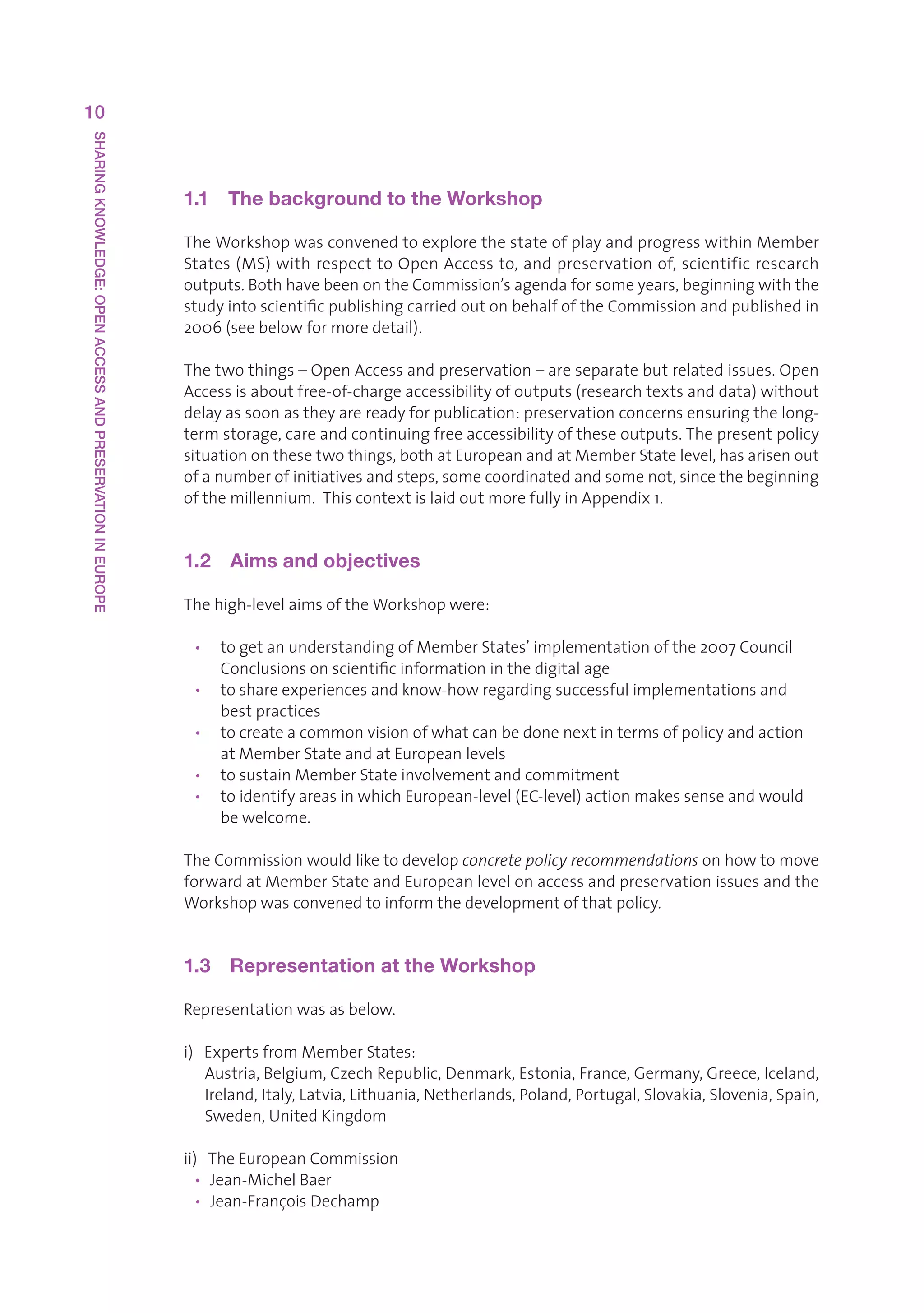
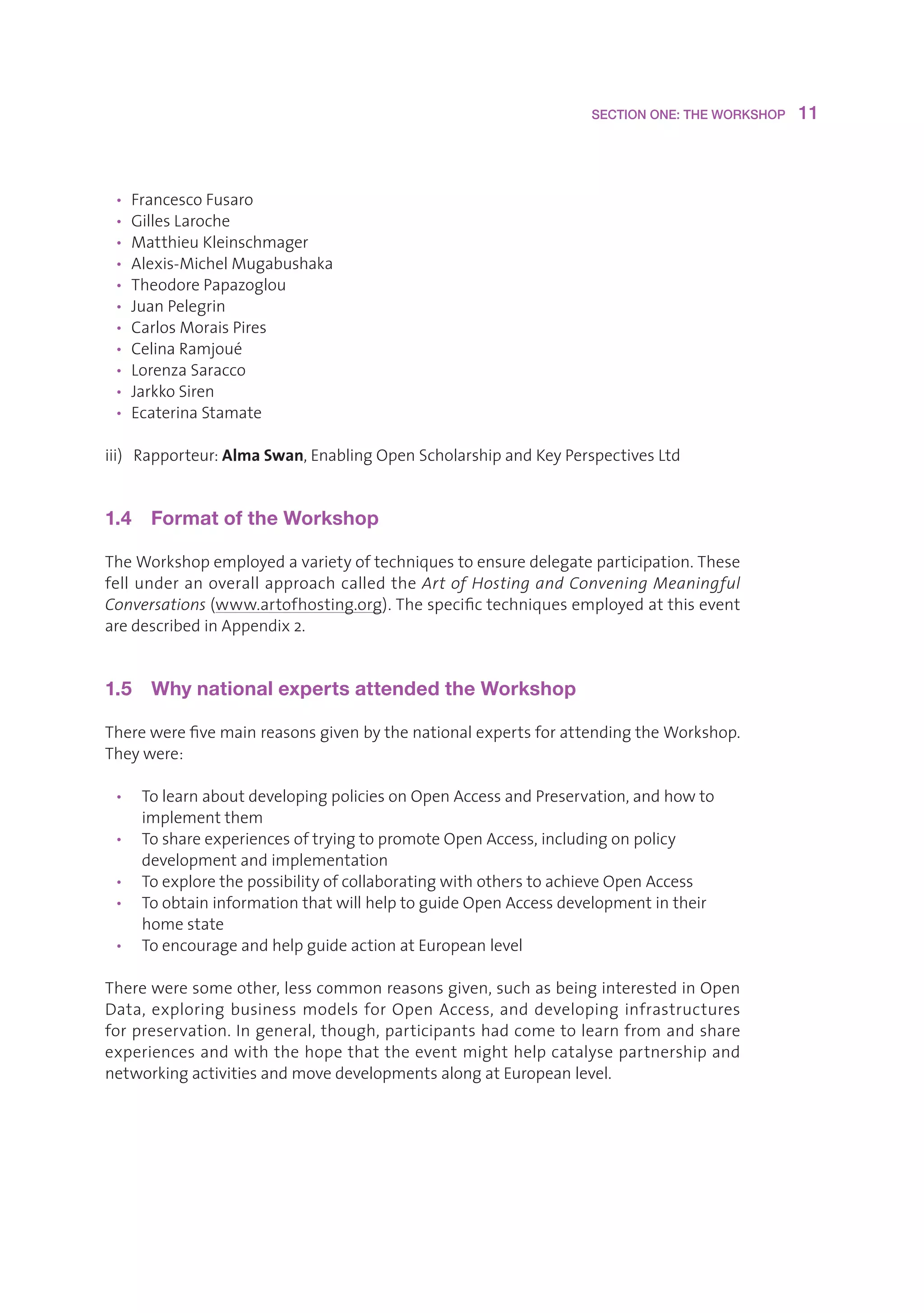
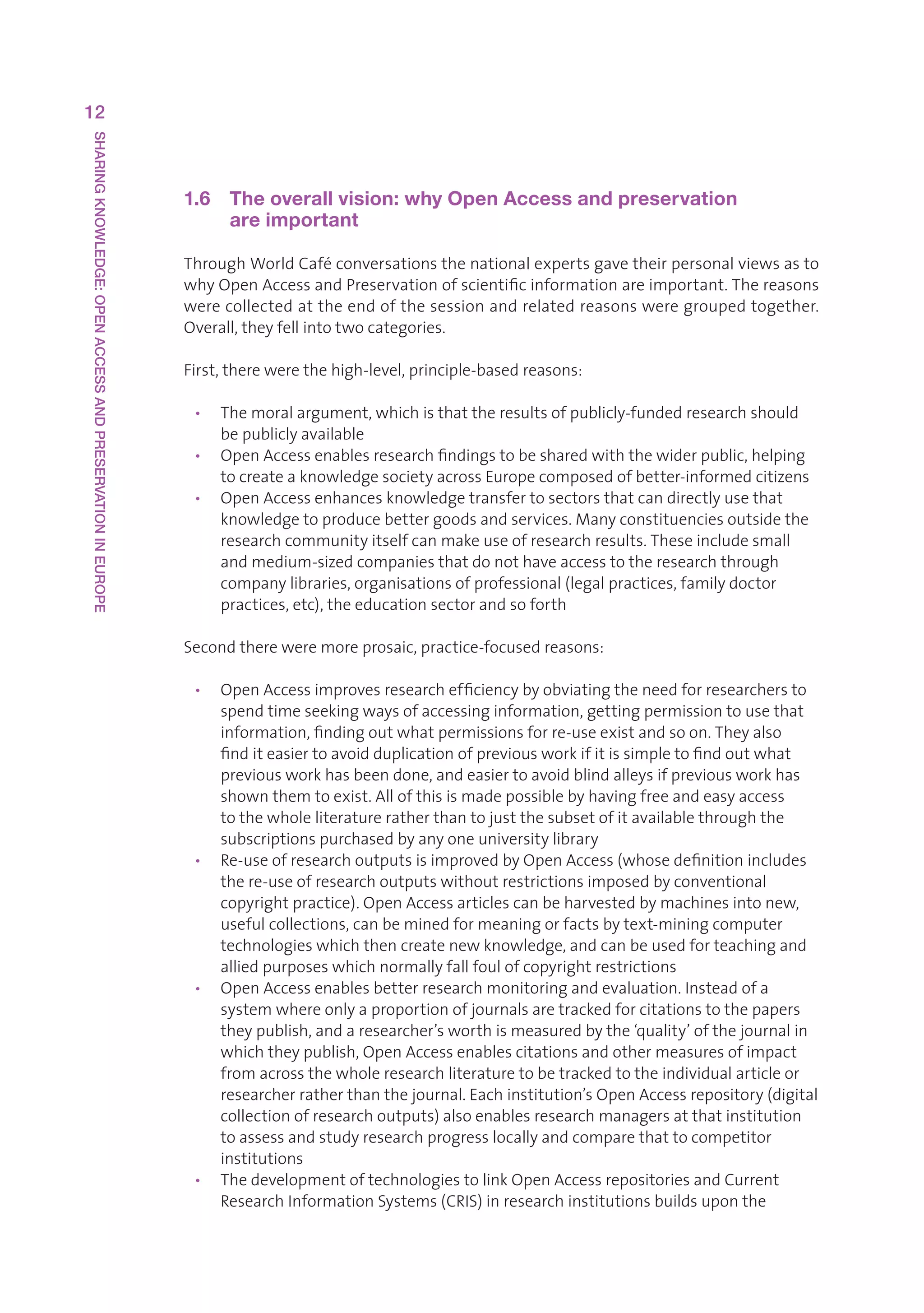
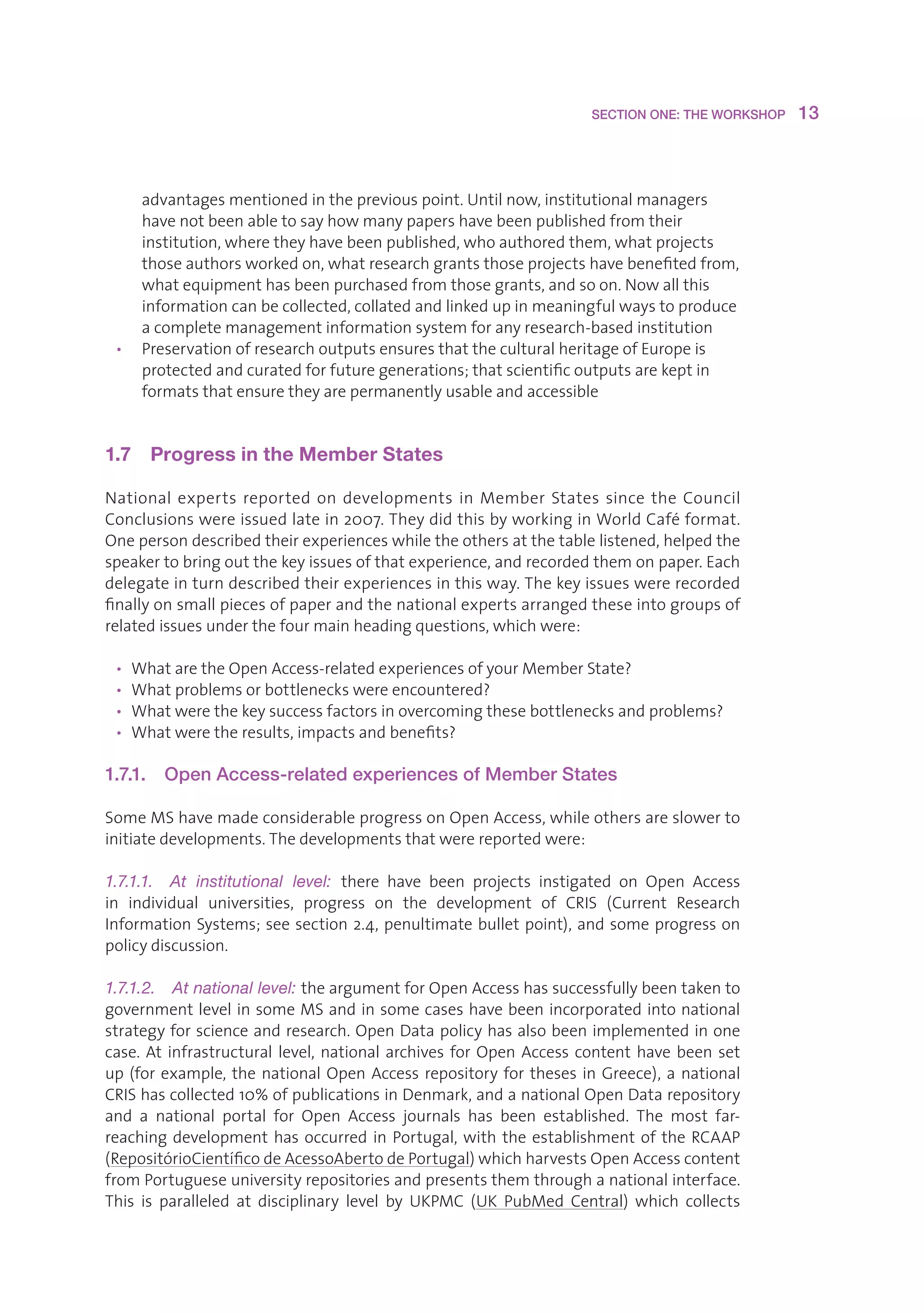
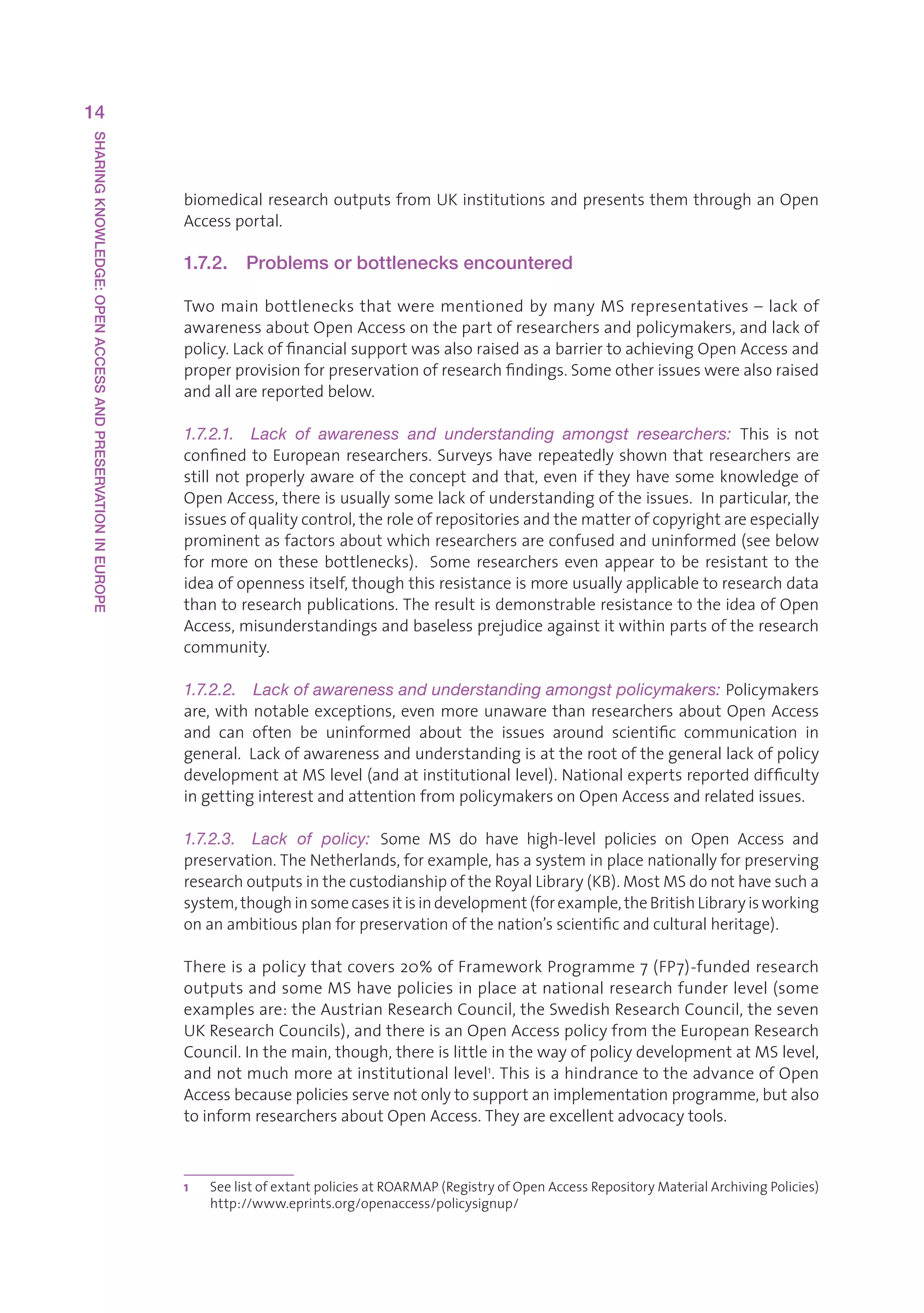
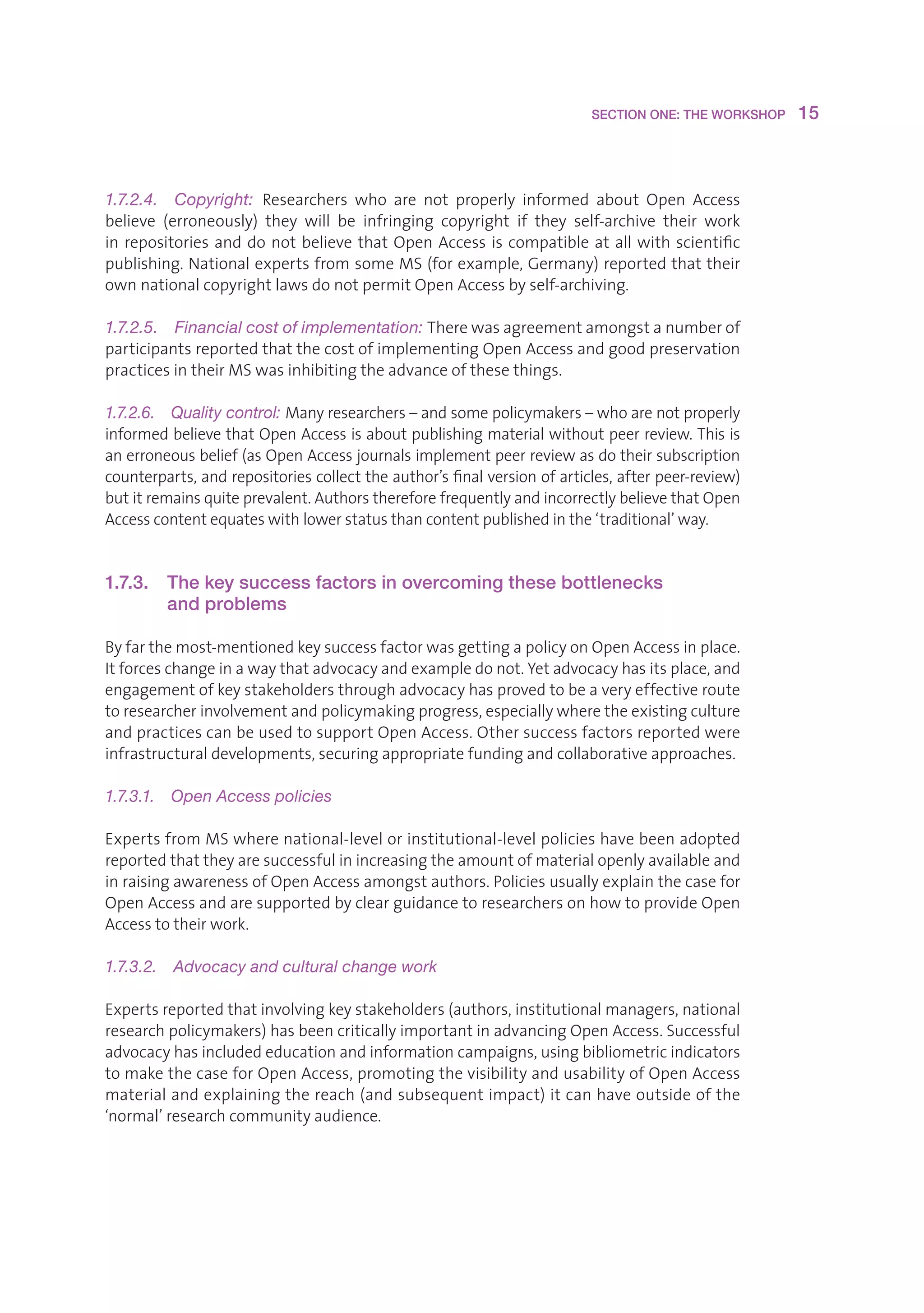
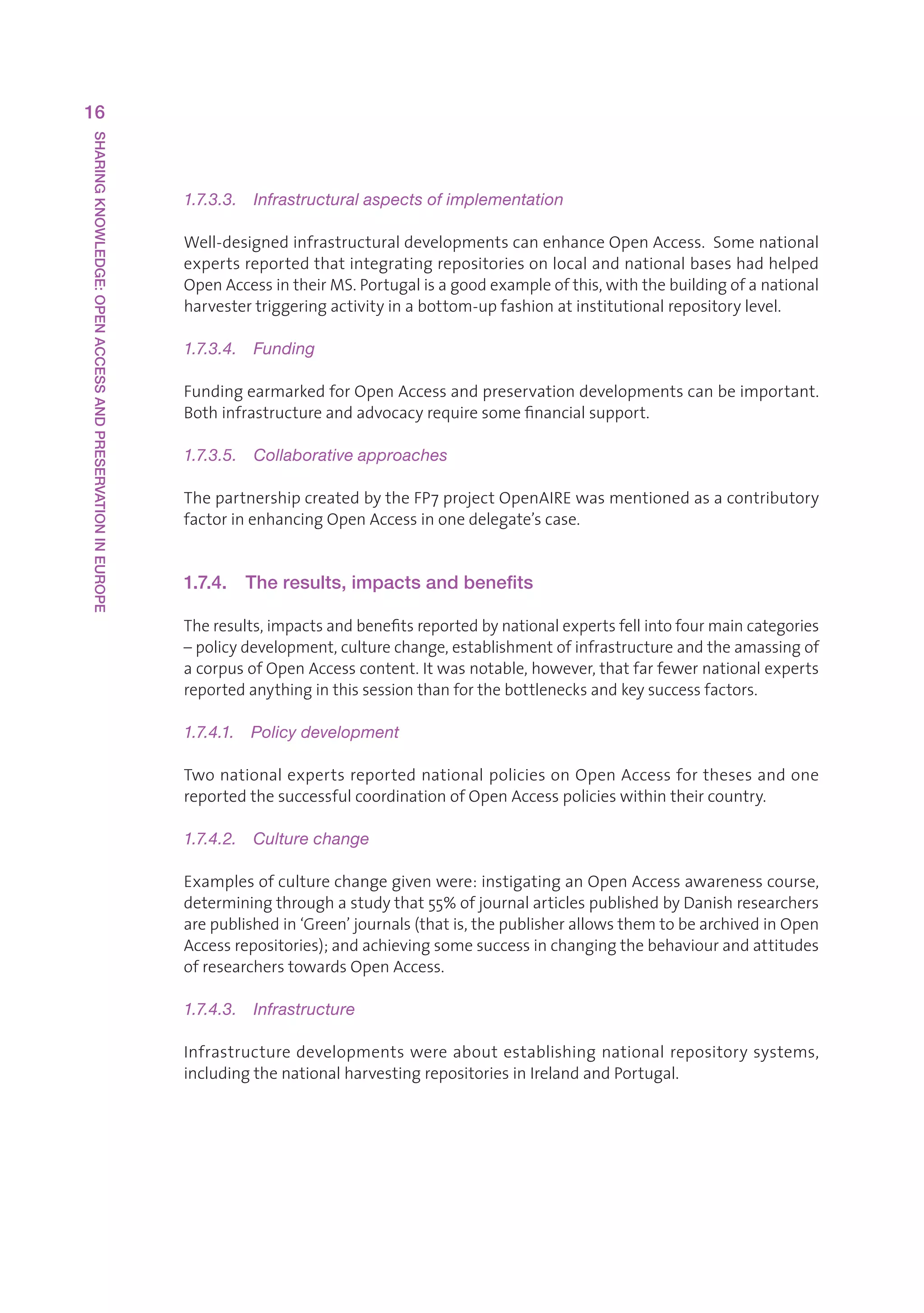
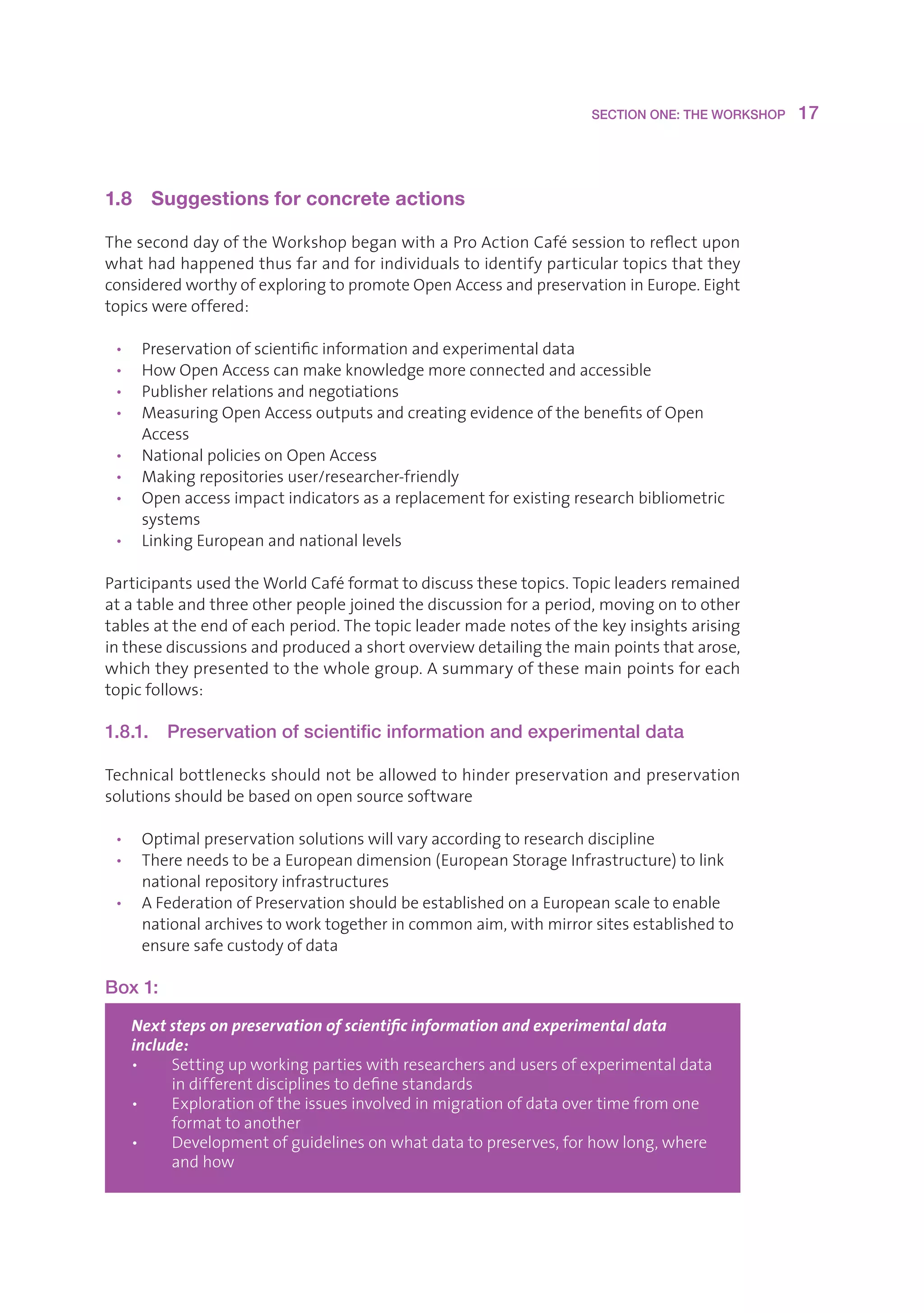
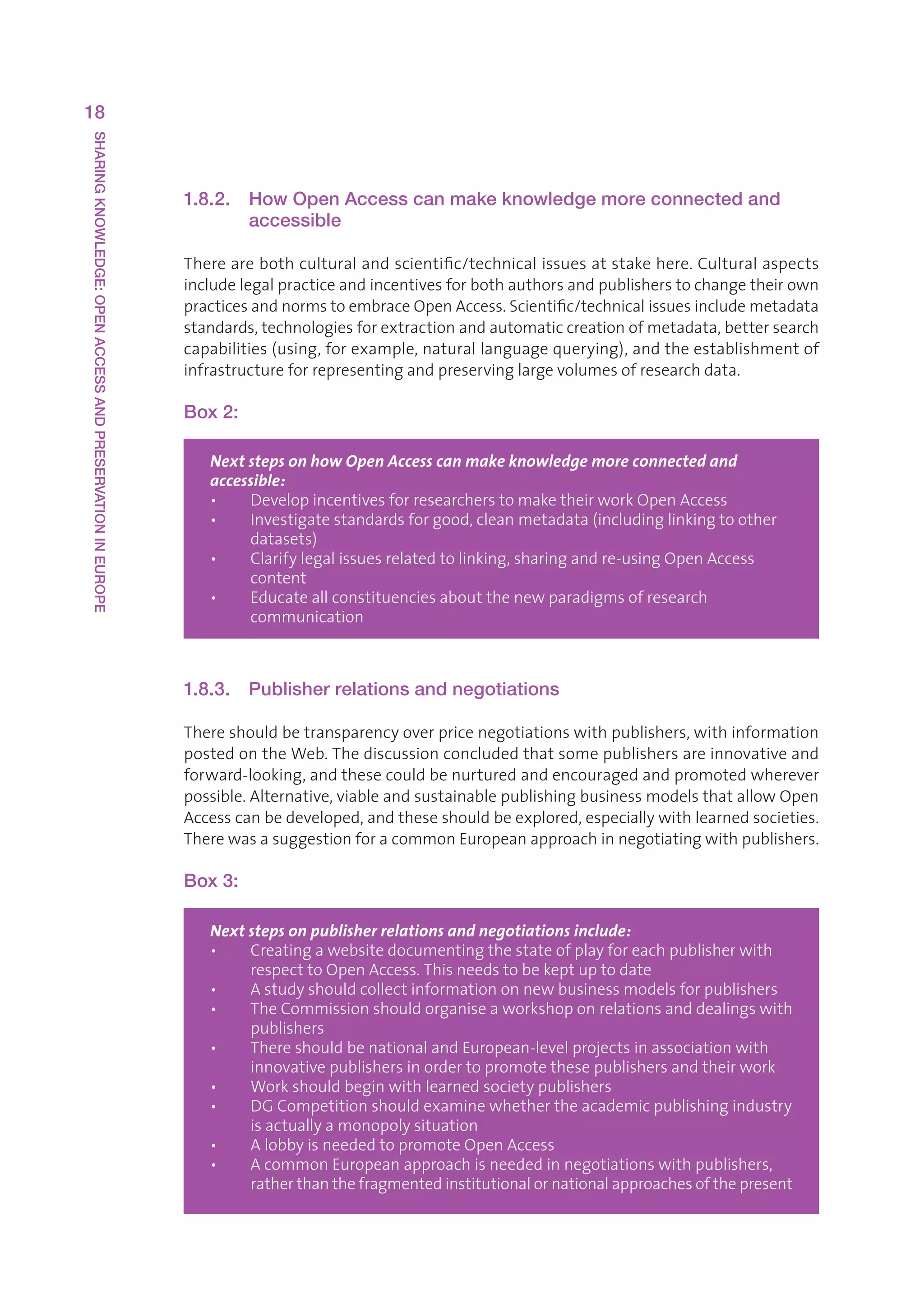
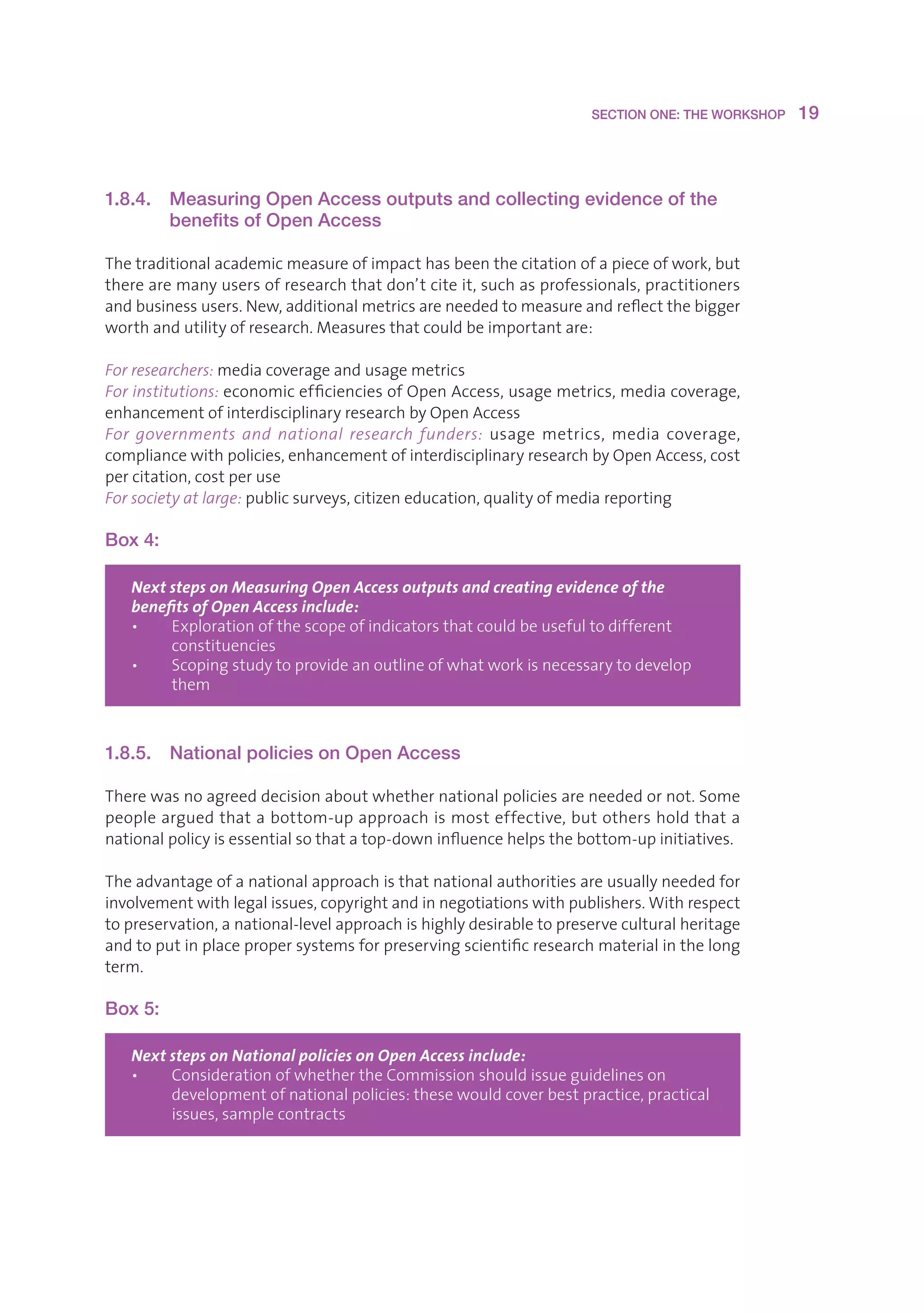
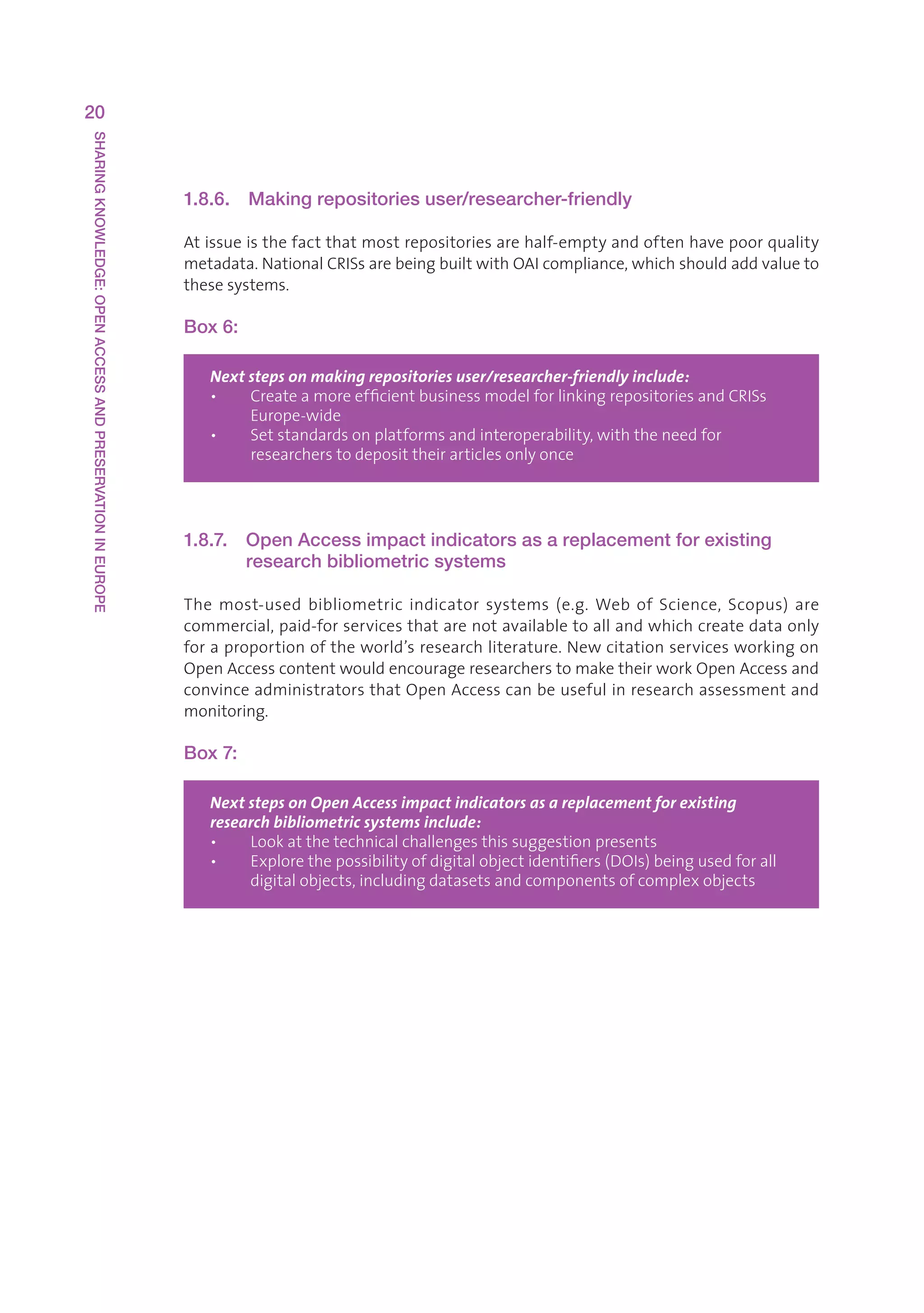
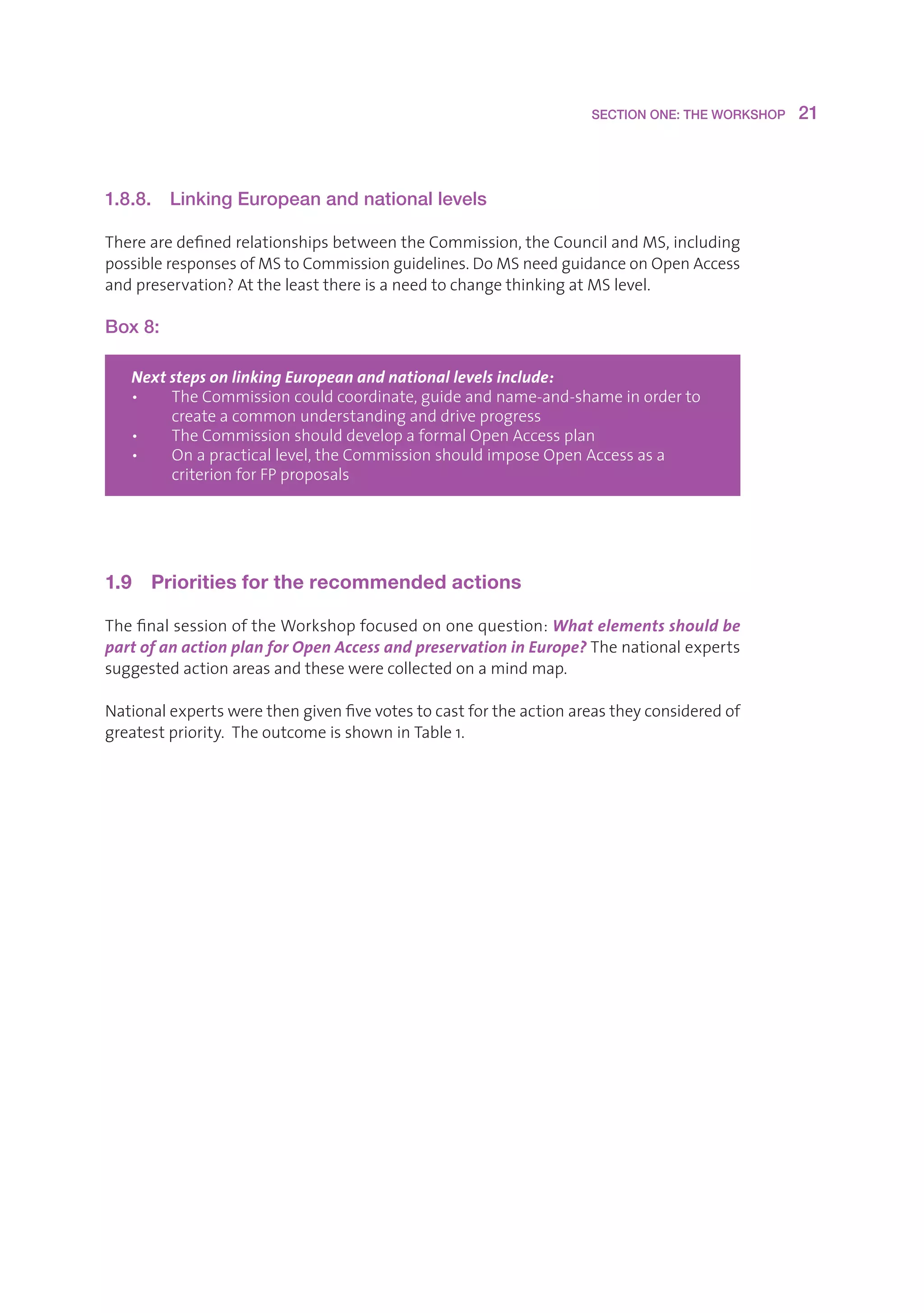
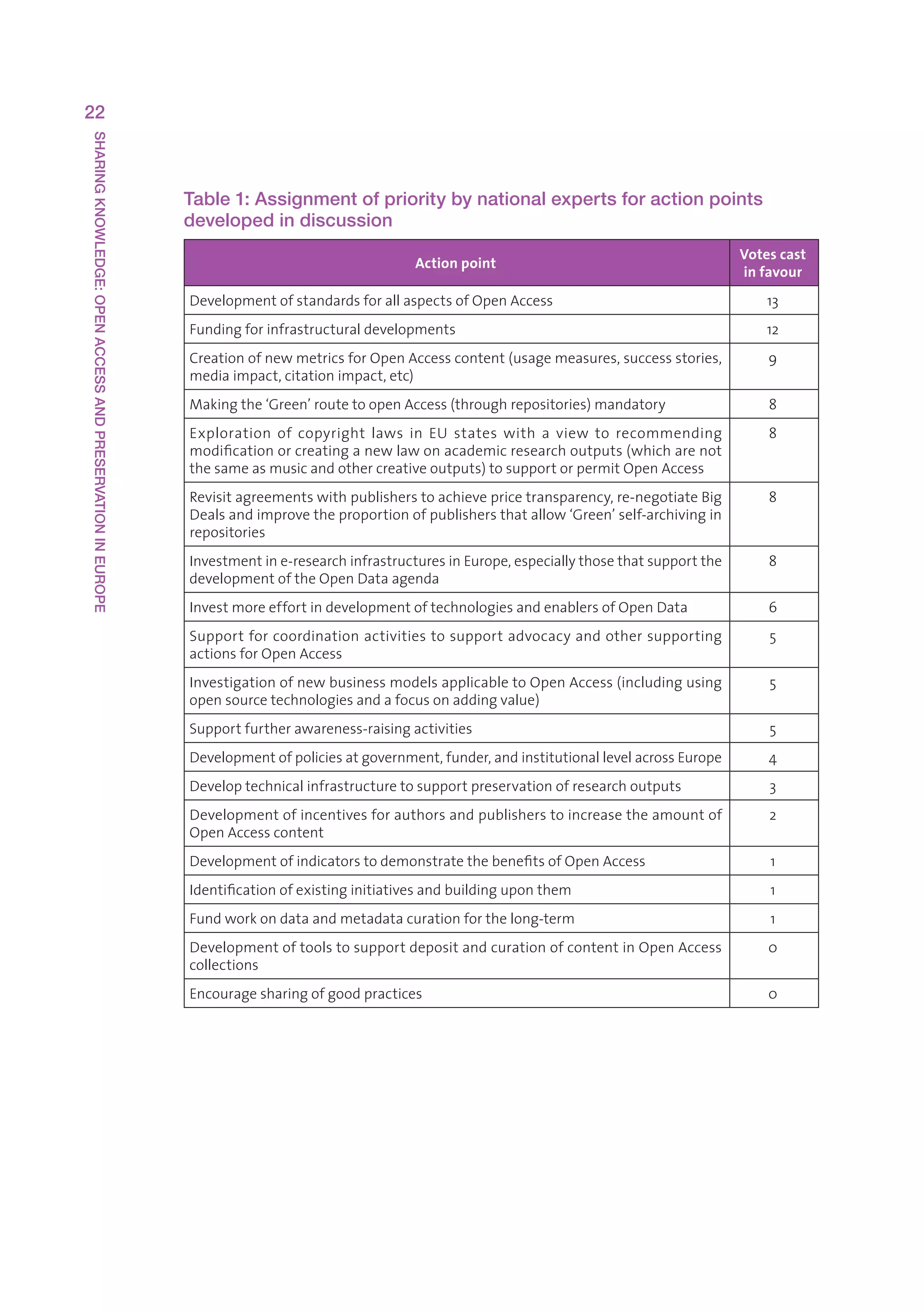
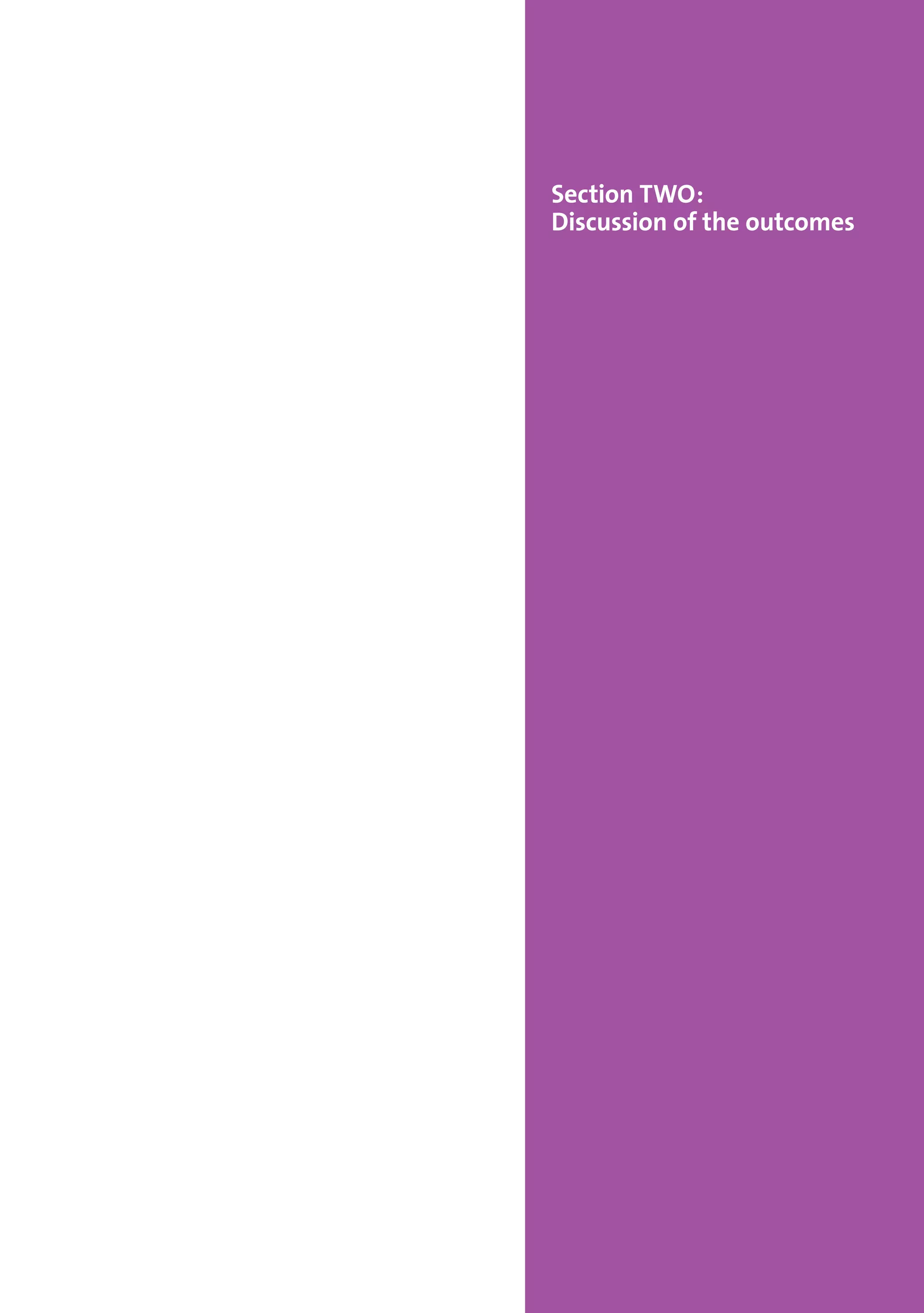
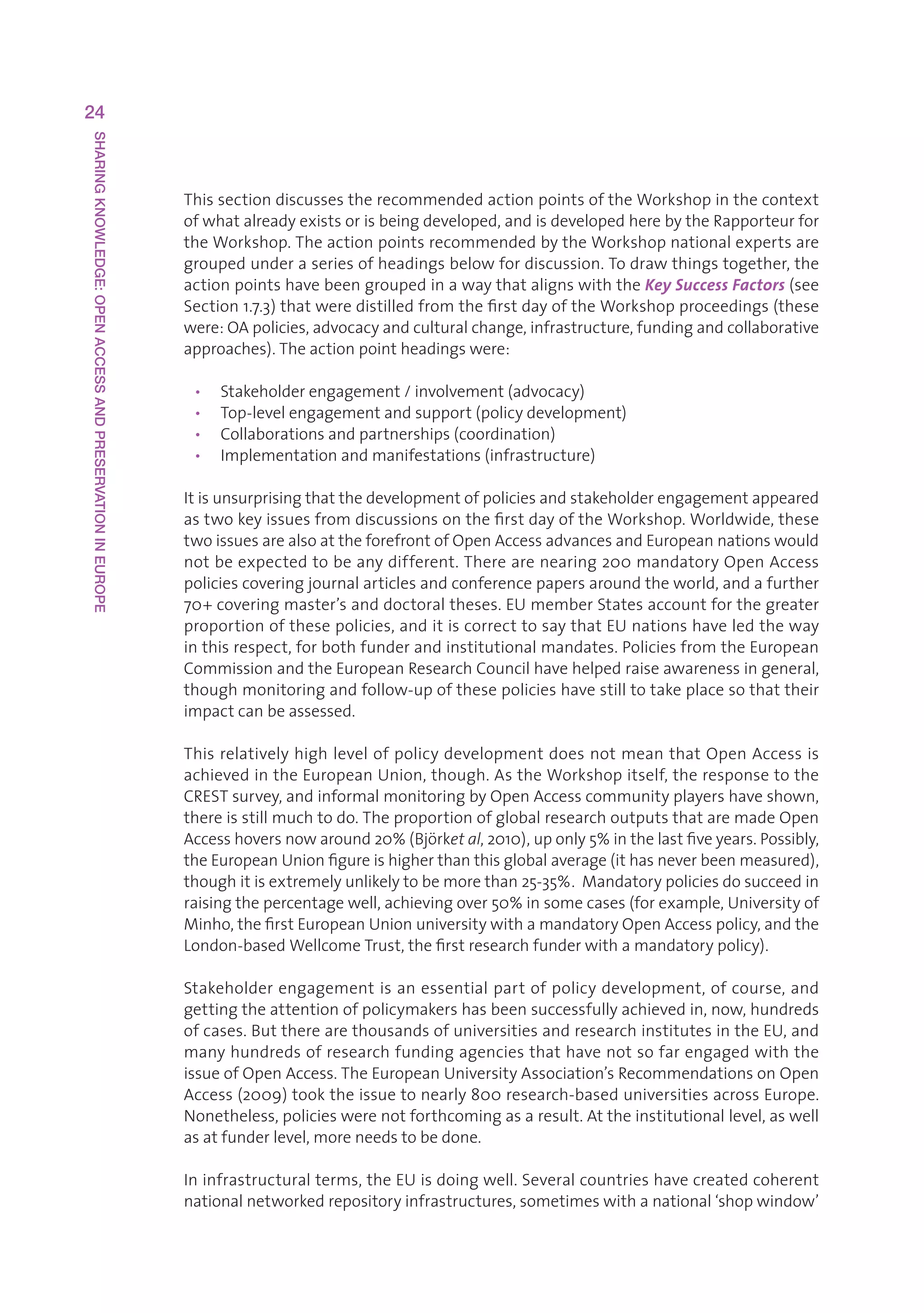
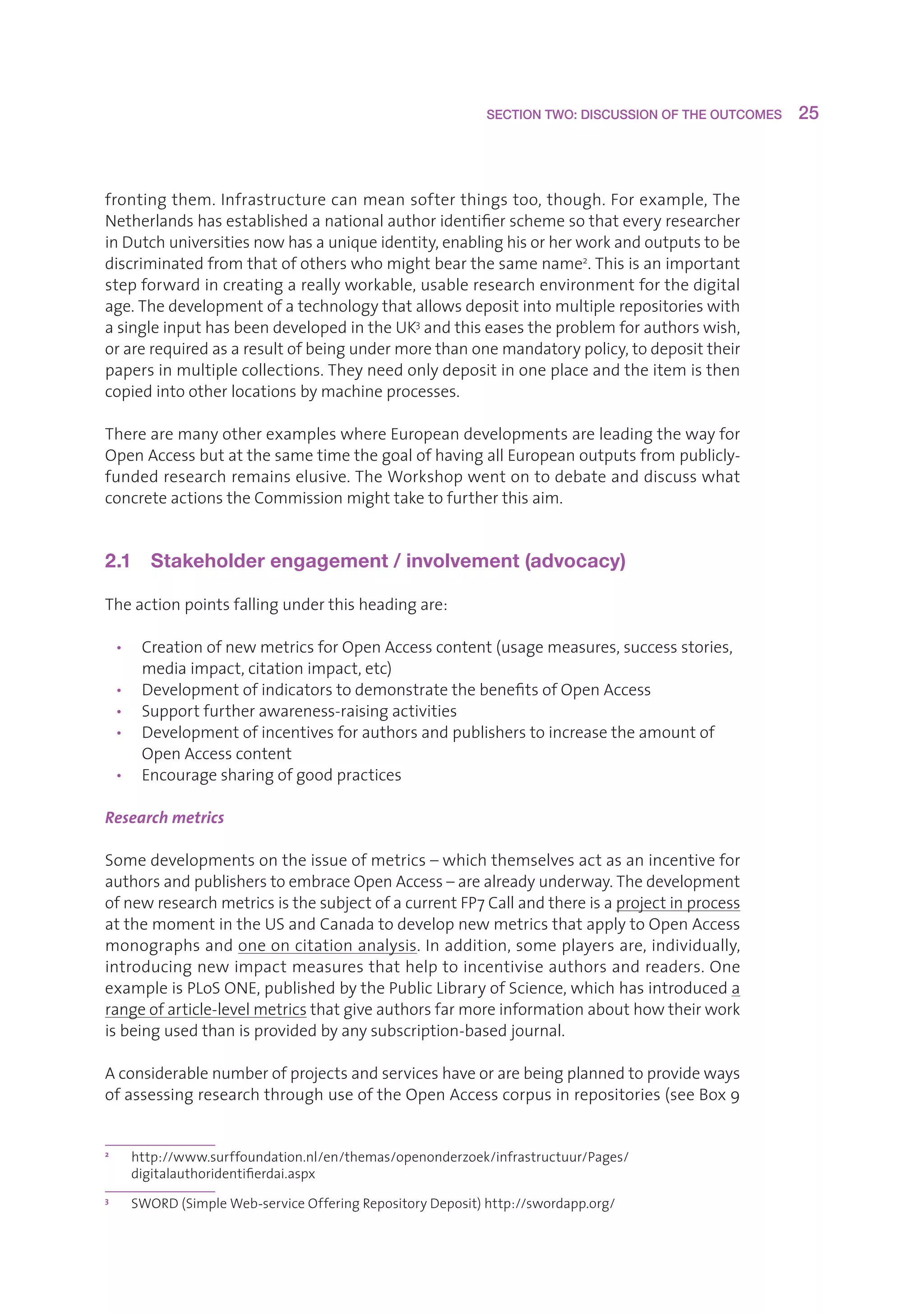
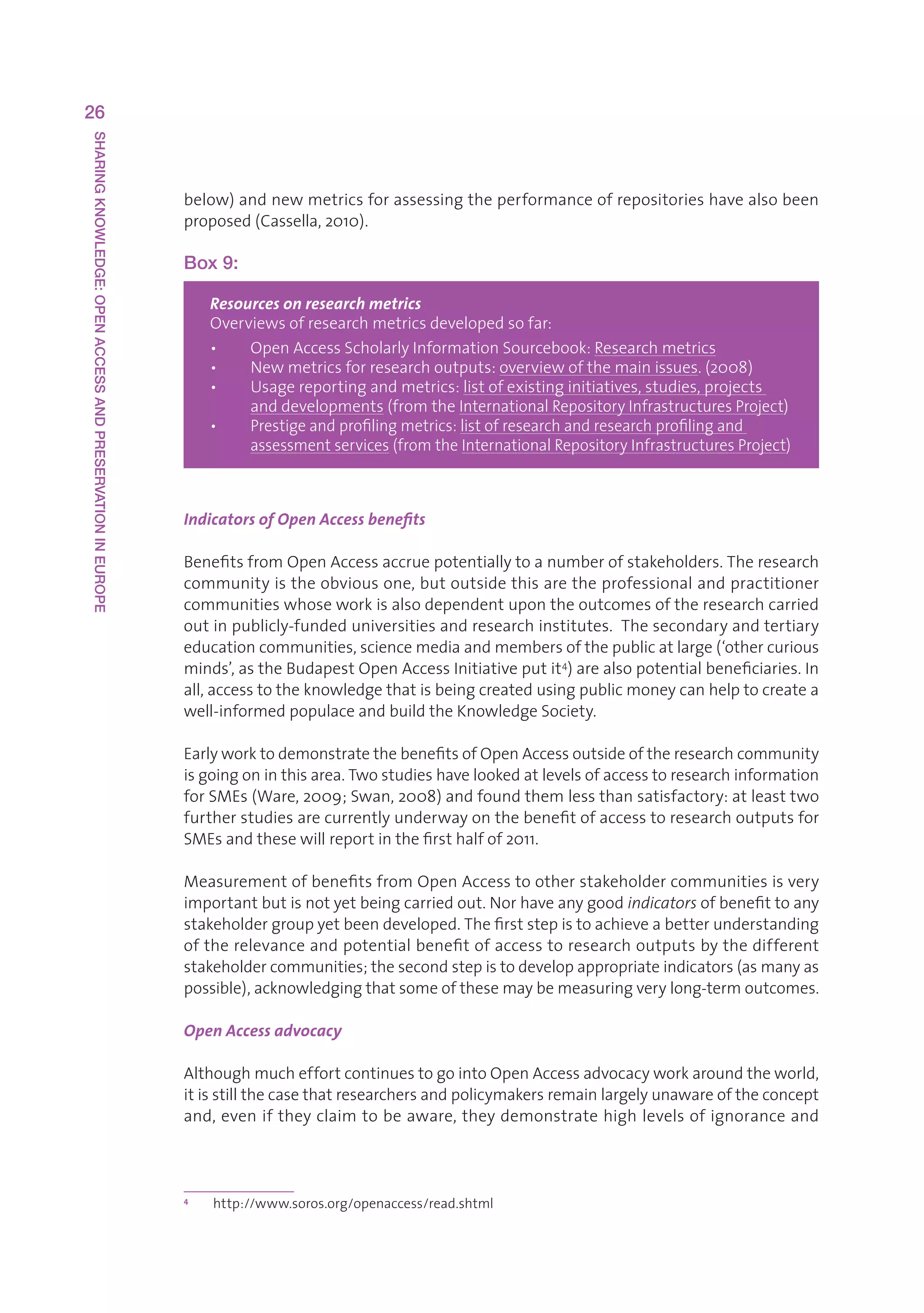
![SECTION TWO: DISCUSSION OF THE OUTCOMES 27
misunderstanding5.Someofthismaybeduetoincorrectinformationeitherinnocentlyor
wilfullyprovidedtothem,butmostlyitisbecauseproperOAadvocacyeffortshavenot
yetreachedtheirtargetcommunitieseffectively.Evenwhereaparticularcommunityhas
receivedhigh-profileinformationandguidanceontheissue,awarenessremainswoefully
low(Bardynet al,2010).
ThisissuewashighlightedduringtheWorkshopandisencapsulatedintwooftheaction
pointsattheheadofthissection.OneofthevaluableoutcomesoftheWorkshopwasthe
opportunityfornationalexpertstosharetheirexperiencesofadvocacyandrelatewhat
hasworkedwellandwhatnotsowell,identifyingtheproblemsanddiscussingwaysto
overcomethem.Furthereventsandinitiativeswouldofferthechancetostimulatedeeper
integrationbetweenMSwithrespecttoadvocacyactivities.
2.2 Top-level engagement and support (policy development)
Theactionpointsfallingunderthisheadingare:
• Makingthe‘Green’routetoOpenAccess(throughrepositories)mandatory
• Developmentofpoliciesatgovernment,funder,andinstitutionallevelacross
Europe
• ExplorationofcopyrightlawsinEUstateswithaviewtorecommending
modificationorcreatinganewlawonacademicresearchoutputs(whicharenot
thesameasmusicandothercreativeoutputs)tosupportorpermitOpenAccess
MandatorypoliciesonOpenAccessaretheprovenkeytoengenderinghighlevelsof
OpenAccesscontent(Sale,2006).Anyotherkindofpolicy,howeverpersuasive,doesnot
havethesameeffect,evenwhensupportedbyintenseadvocacyandpracticalsupport.
Mandatorypolicies,aswellashavinganobligatoryelement,serveasawareness-raising
toolsthemselves,especiallywhenimplementedalongwithsupportinginformationthat
reassuresandencouragesauthors.
Thereisalackofawarenessaboutthechangingfaceofscholarlycommunicationon
thepartofpolicymakersthemselves,however,especiallyatinstitutionallevel.Though
thenumbersofmandatorypoliciesintroducedininstitutionshasgrownconsiderably
overthelastfewyears6,thishasbeenachievedonlybyintenseadvocacyeffortwithin
institutionsandbyadvocacyorganisations.Governmentsandlargeresearchfunding
5
A
surveyofmembersofUKlearnedsocietiesbytheAssociationofLearnedandProfessionalSociety
Publishers(ALPSP)foundthatmostsaidtheyknewwhatOAwasandsupportedtheideaofOA
journals,whilefewknewwhattheyweretalkingabout.‘[A]lthough60%saidthattheyreadOA
journalsand25%thattheypublishedinthem,inbothcasesaroundone-thirdofthejournalsnamed
werenotOA.”Inaddition“lessthanhalfknewwhatself-archivingwas;36%thoughtitwasagood
ideaand50%wereunsure.Justunderhalfsaidtheyusedrepositoriesofself-archivedarticles,but
13%ofreferenceswerenotinfacttoself-archivingrepositories.29%saidtheyself-archivedtheirown
articles,but10%ofreferenceswerenottopubliclyaccessiblesitesofanykind.’(FromtheSPARC
Open Access Newsletter, January 2011, by Peter Suber: http://www.earlham.edu/~peters/fos/
newsletter/01-02-11.htm)
6
http://bit.ly/dyWWaA](https://image.slidesharecdn.com/ki3111187ennwebupdatedforemaildeletetheotherone-111129025024-phpapp01/75/Knowledge-sharing-OA-and-preservation-in-Europe-29-2048.jpg)
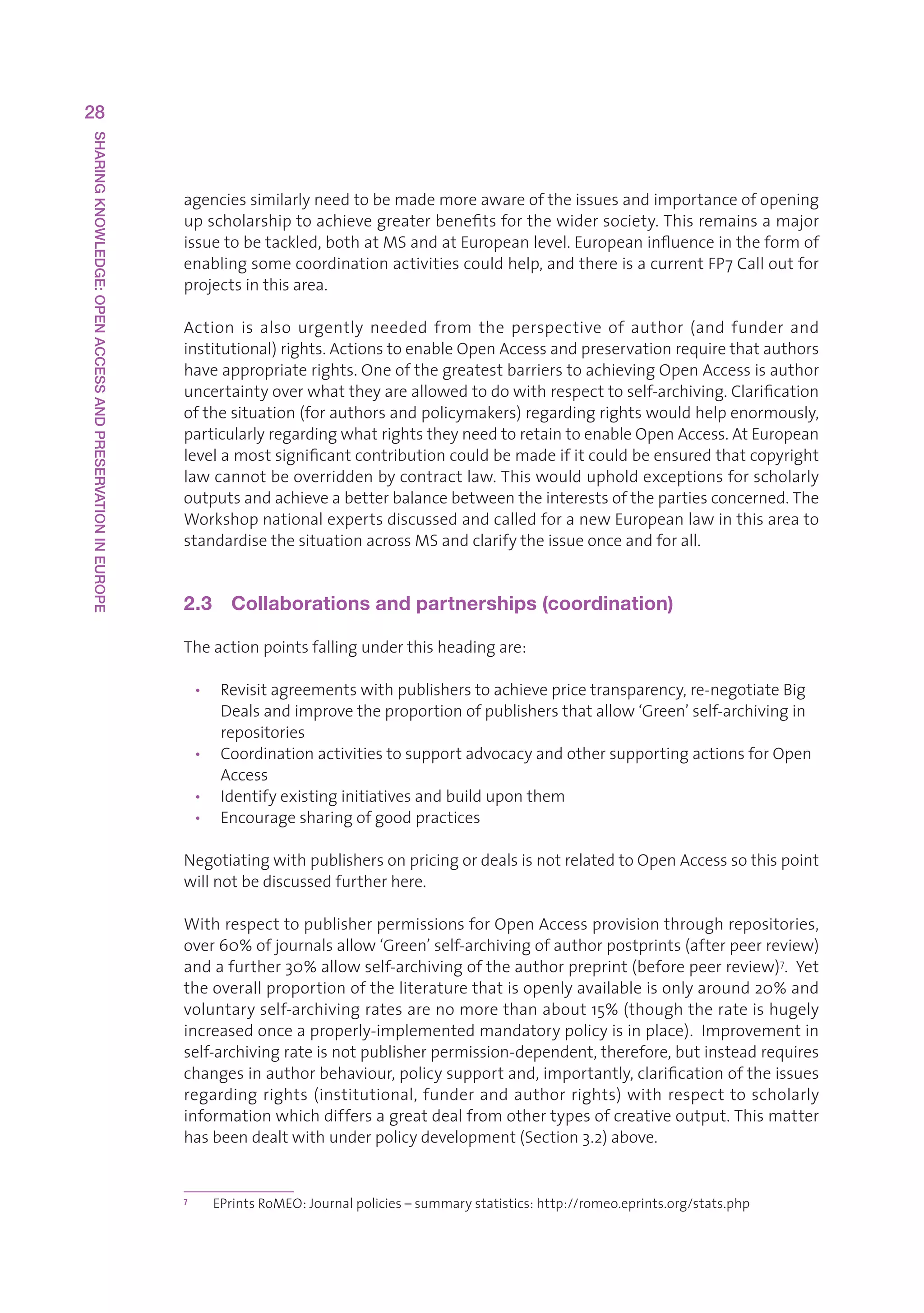
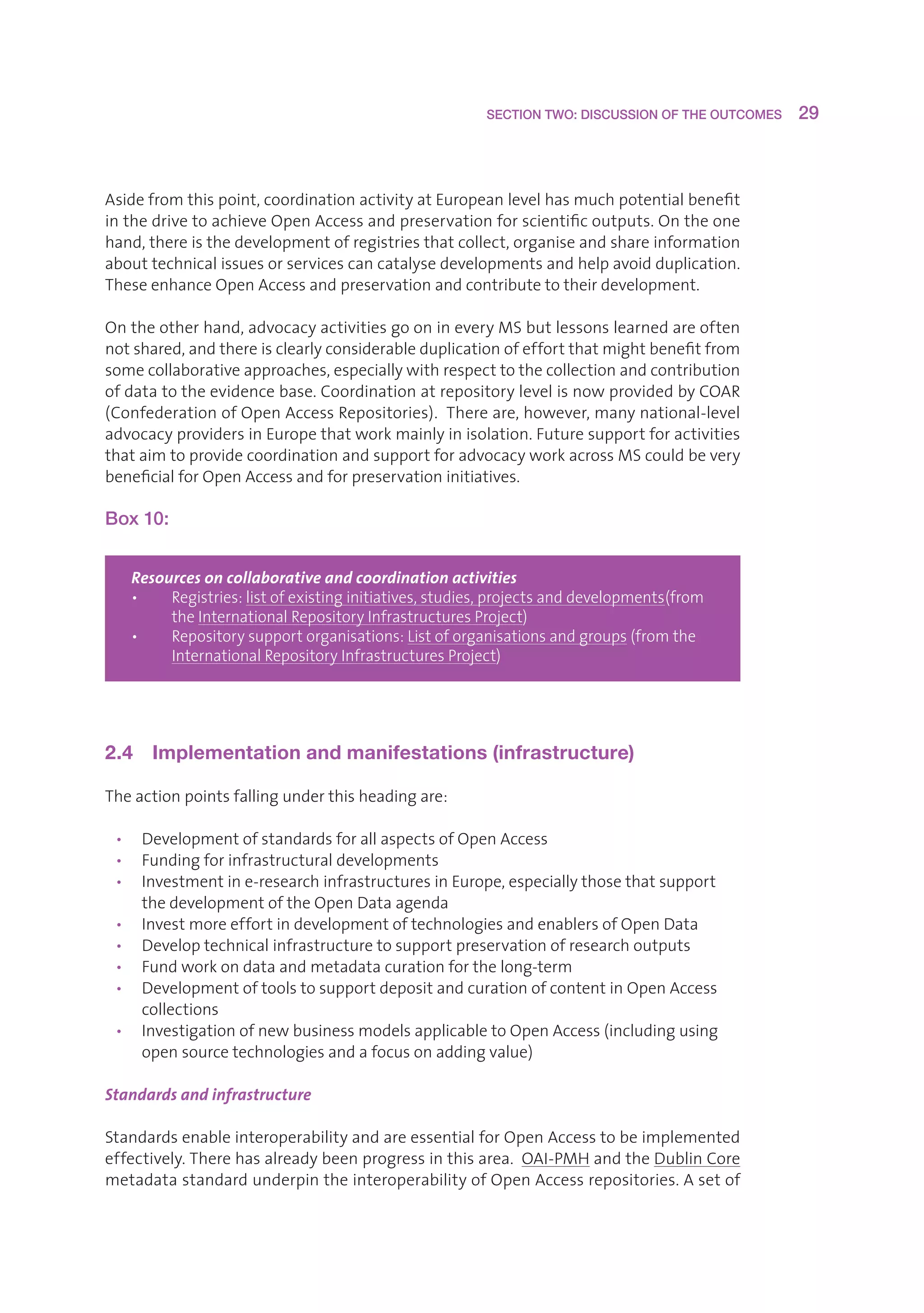
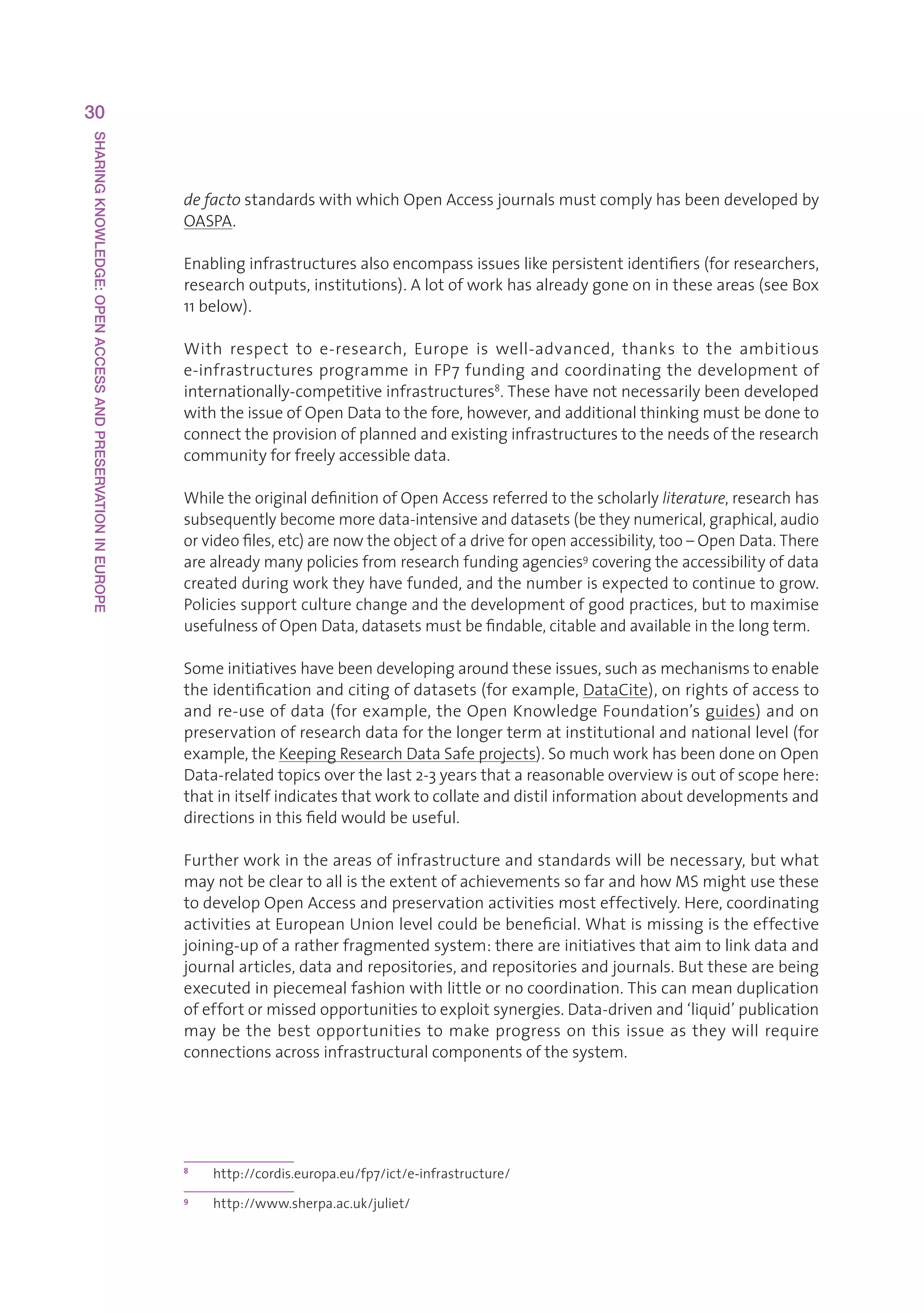
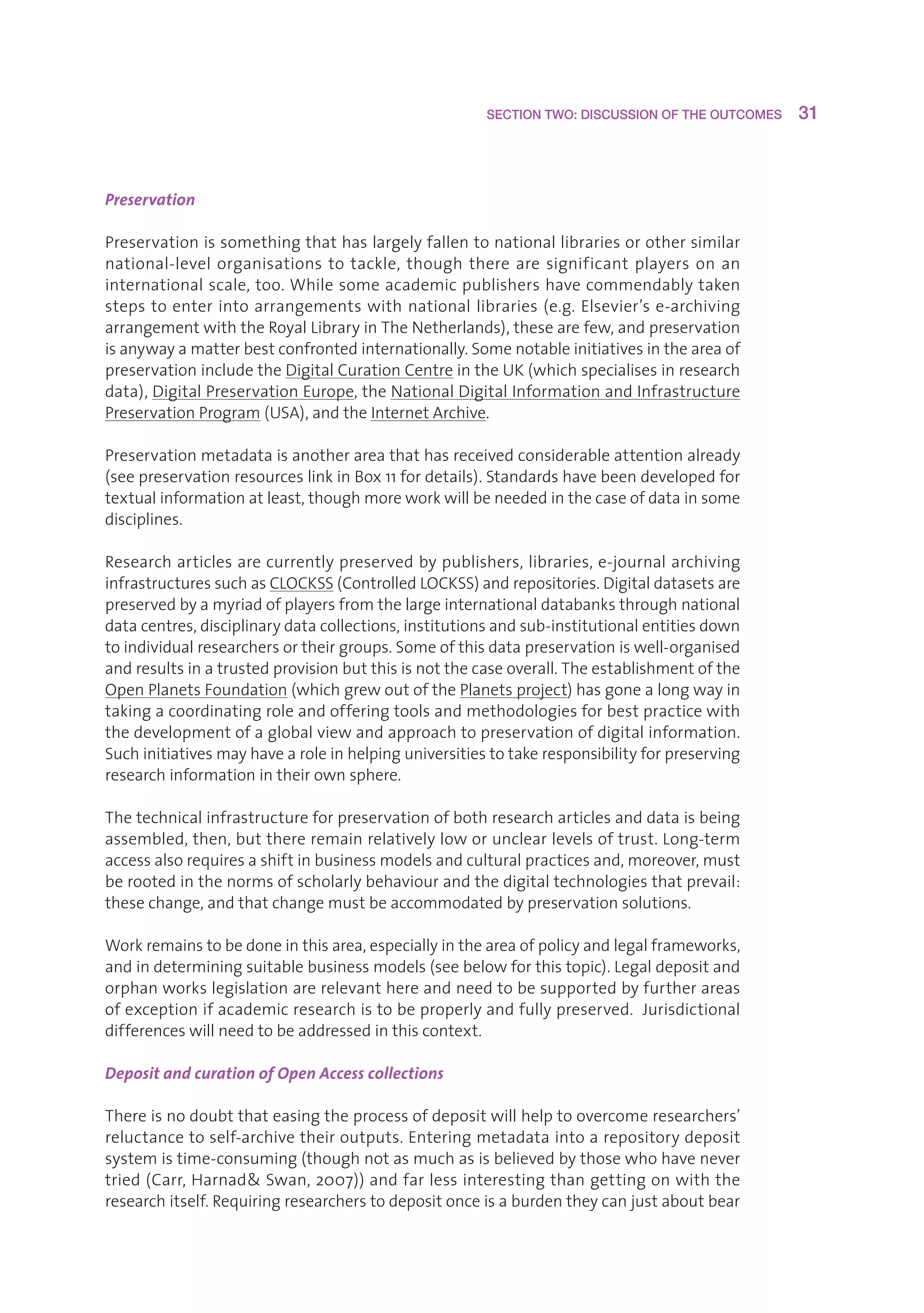
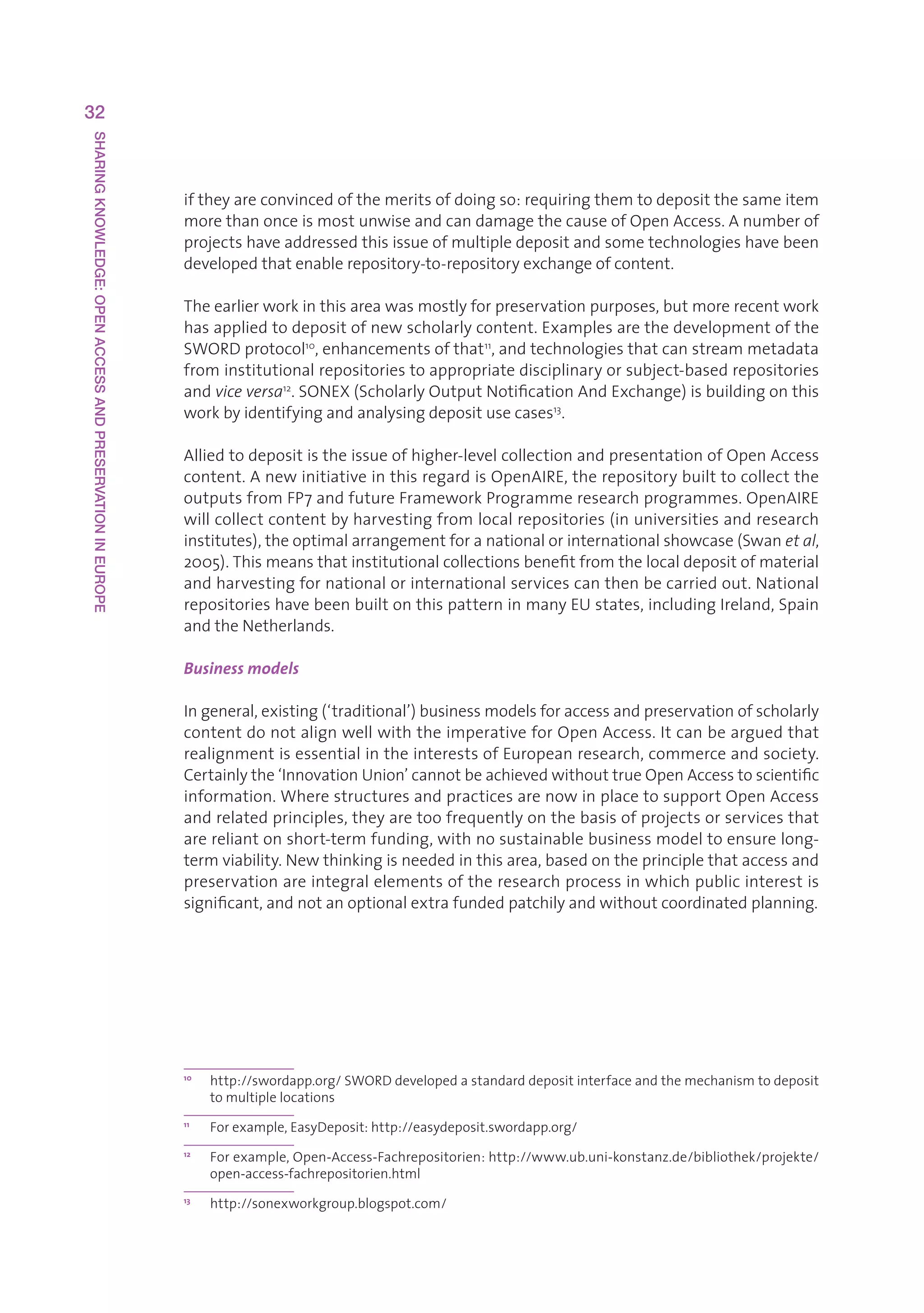
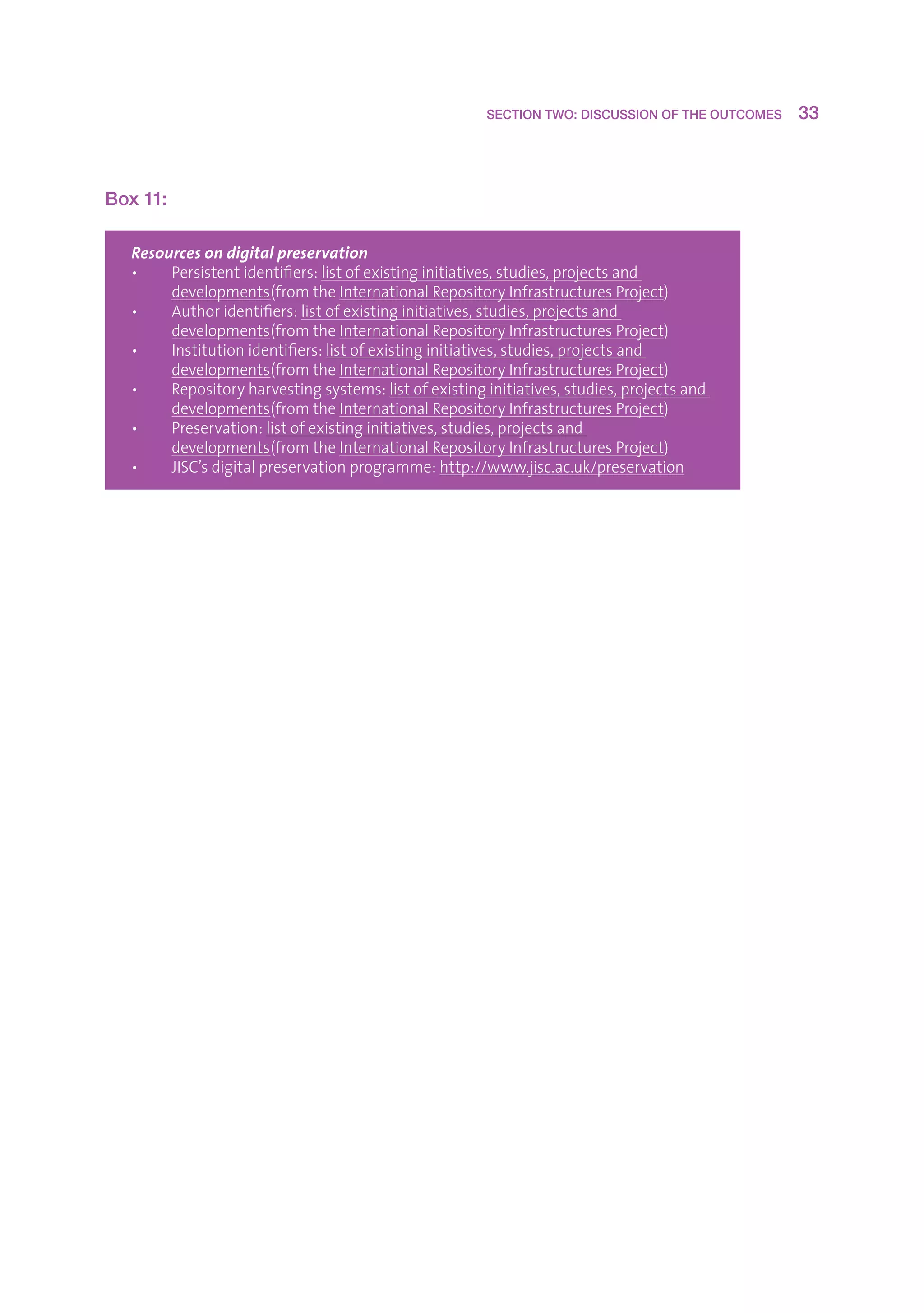

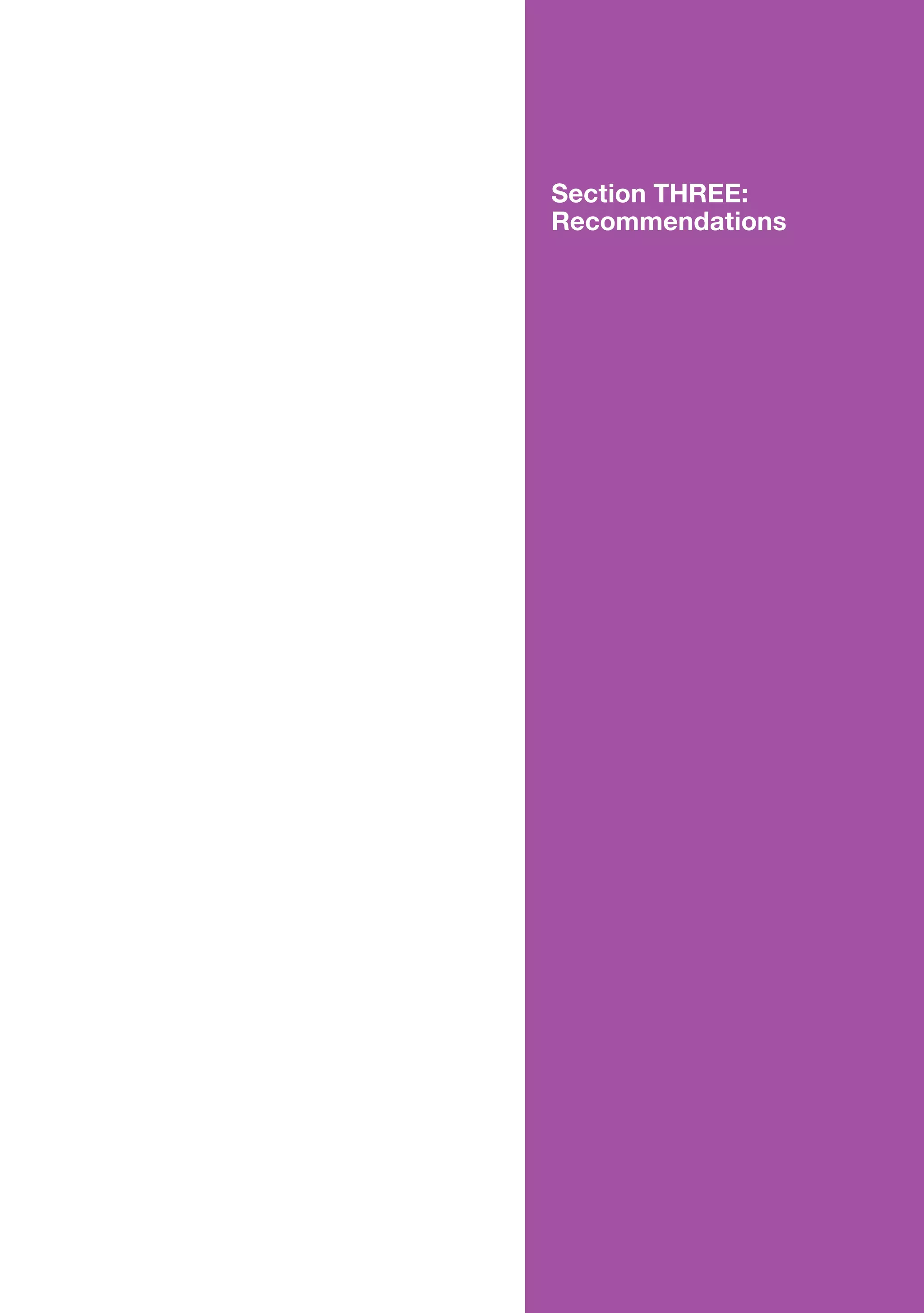
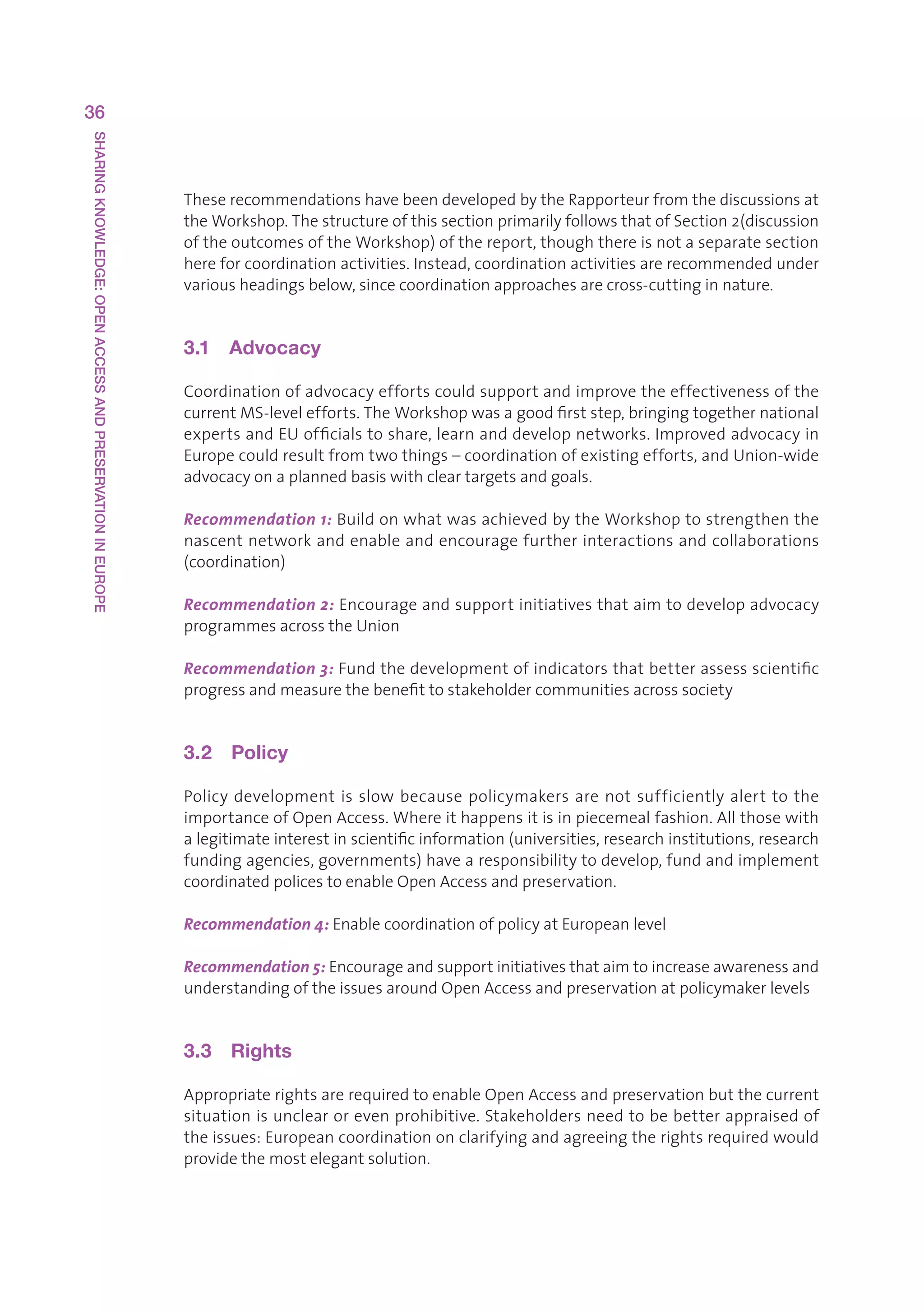
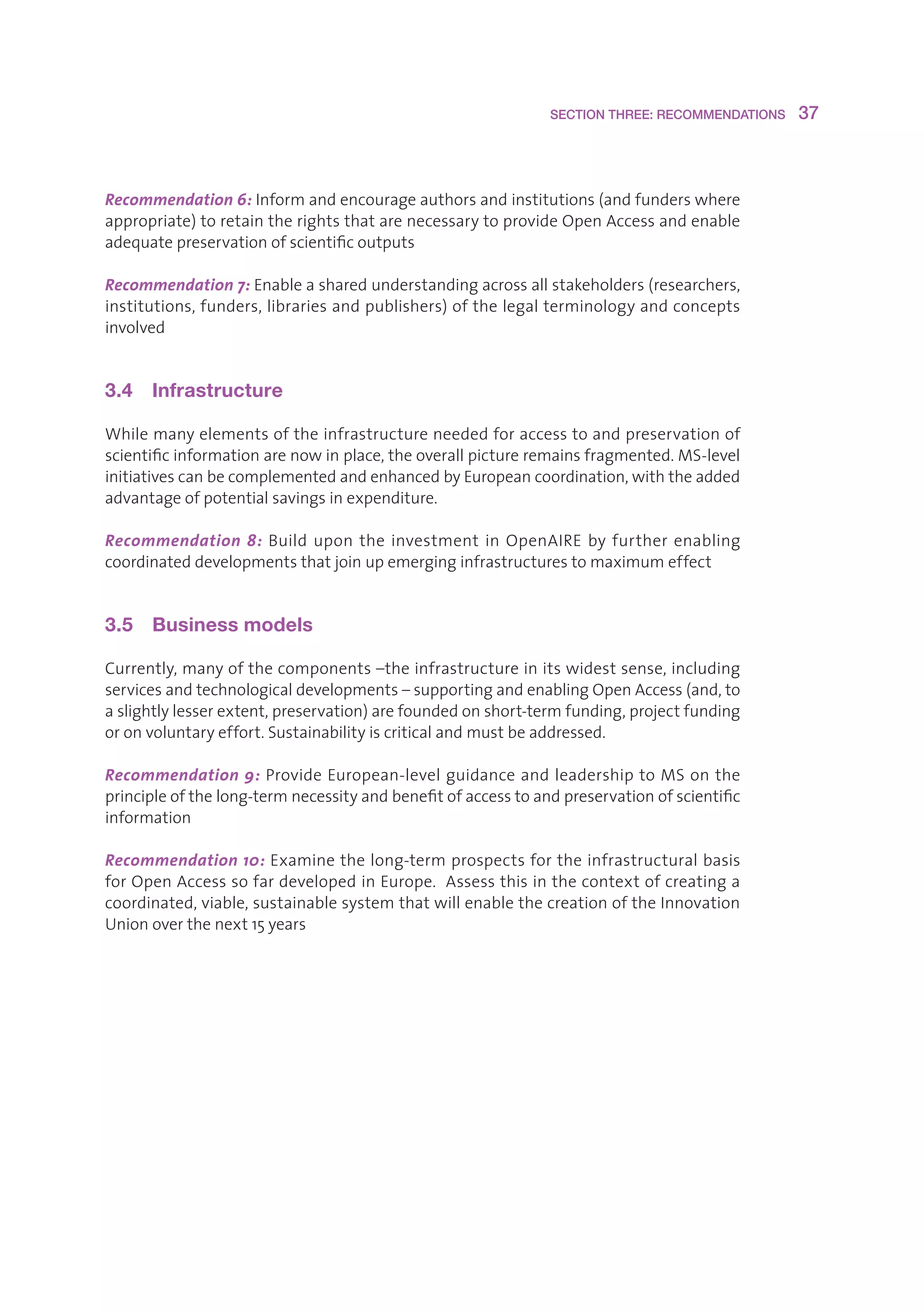
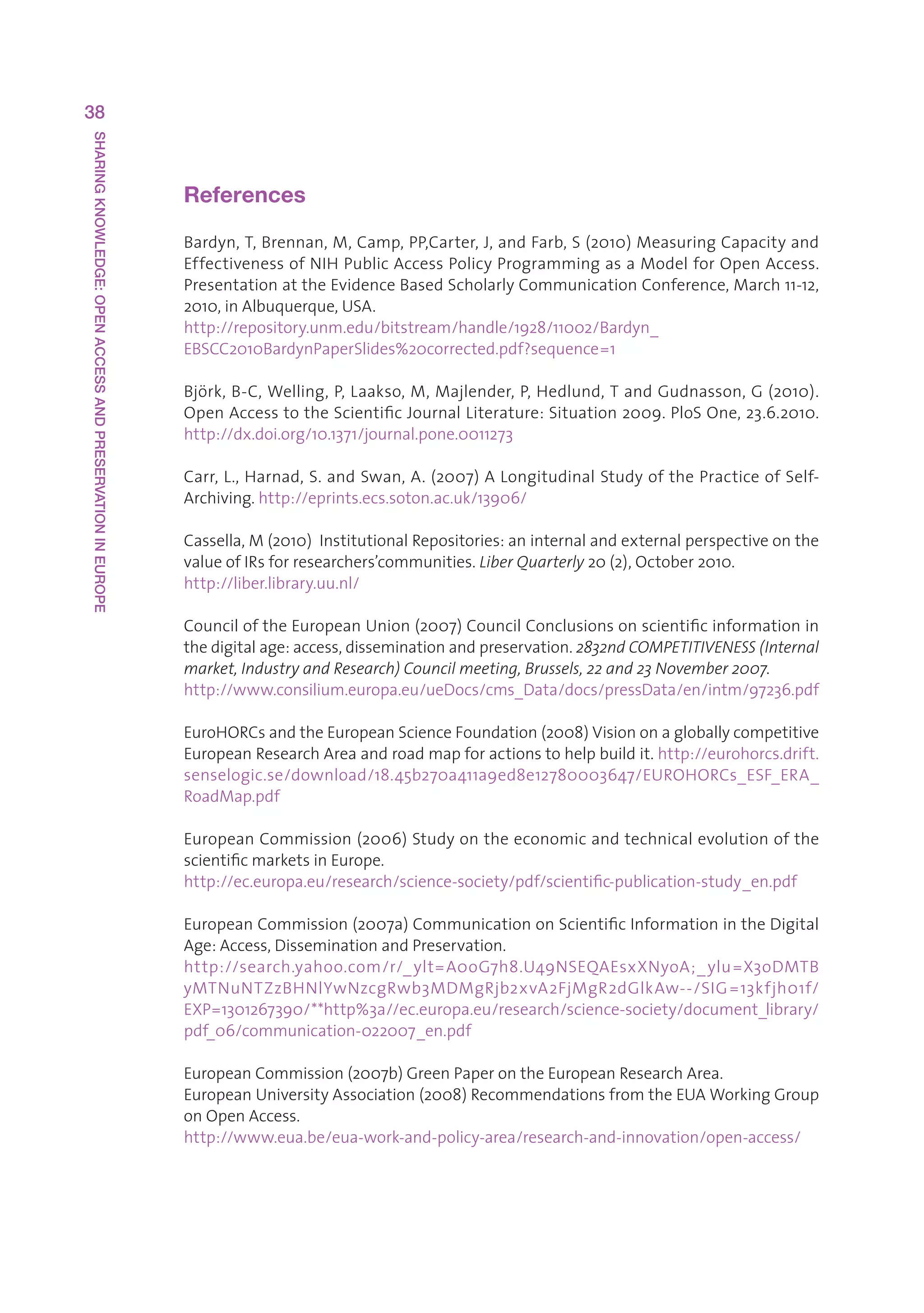
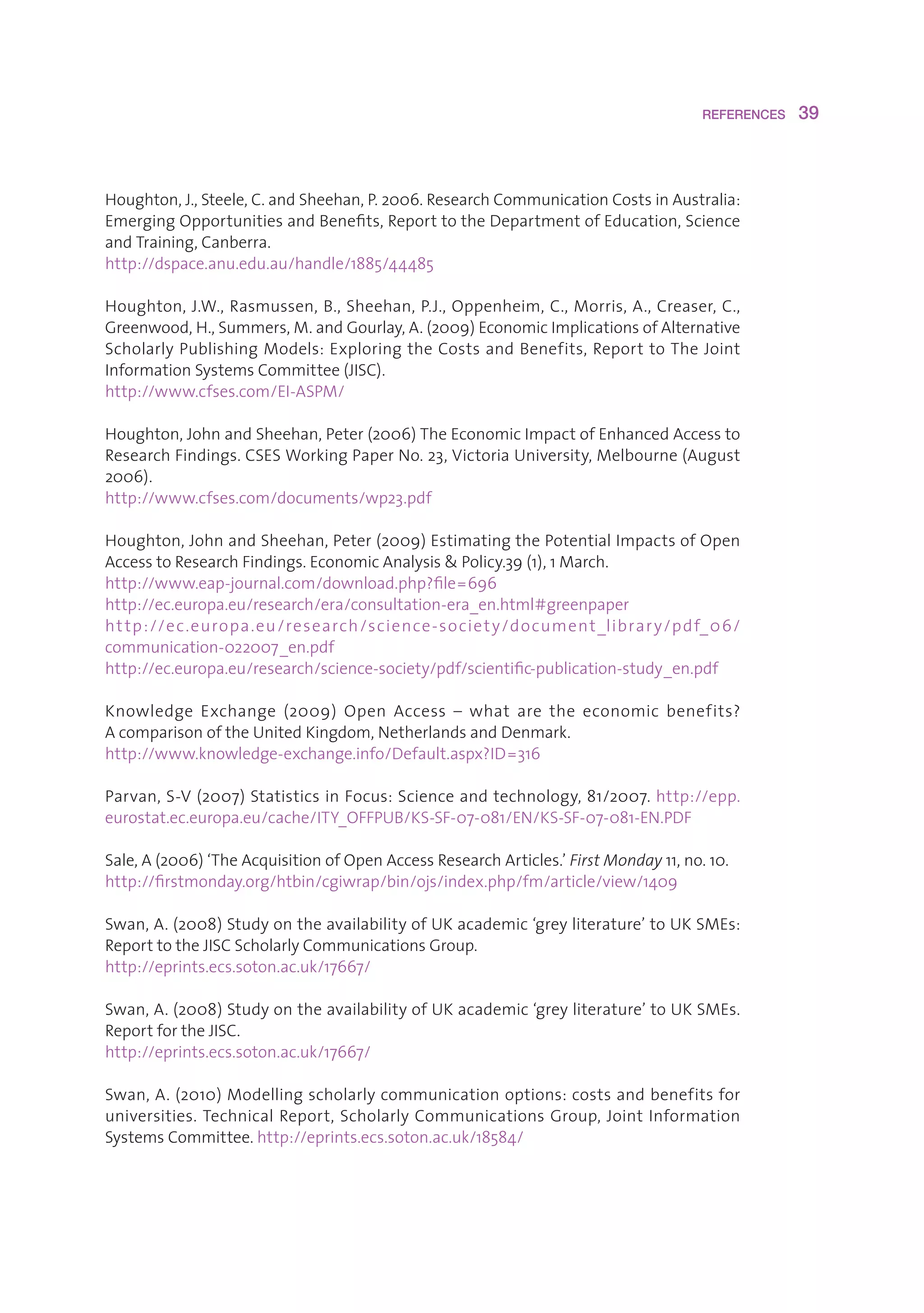
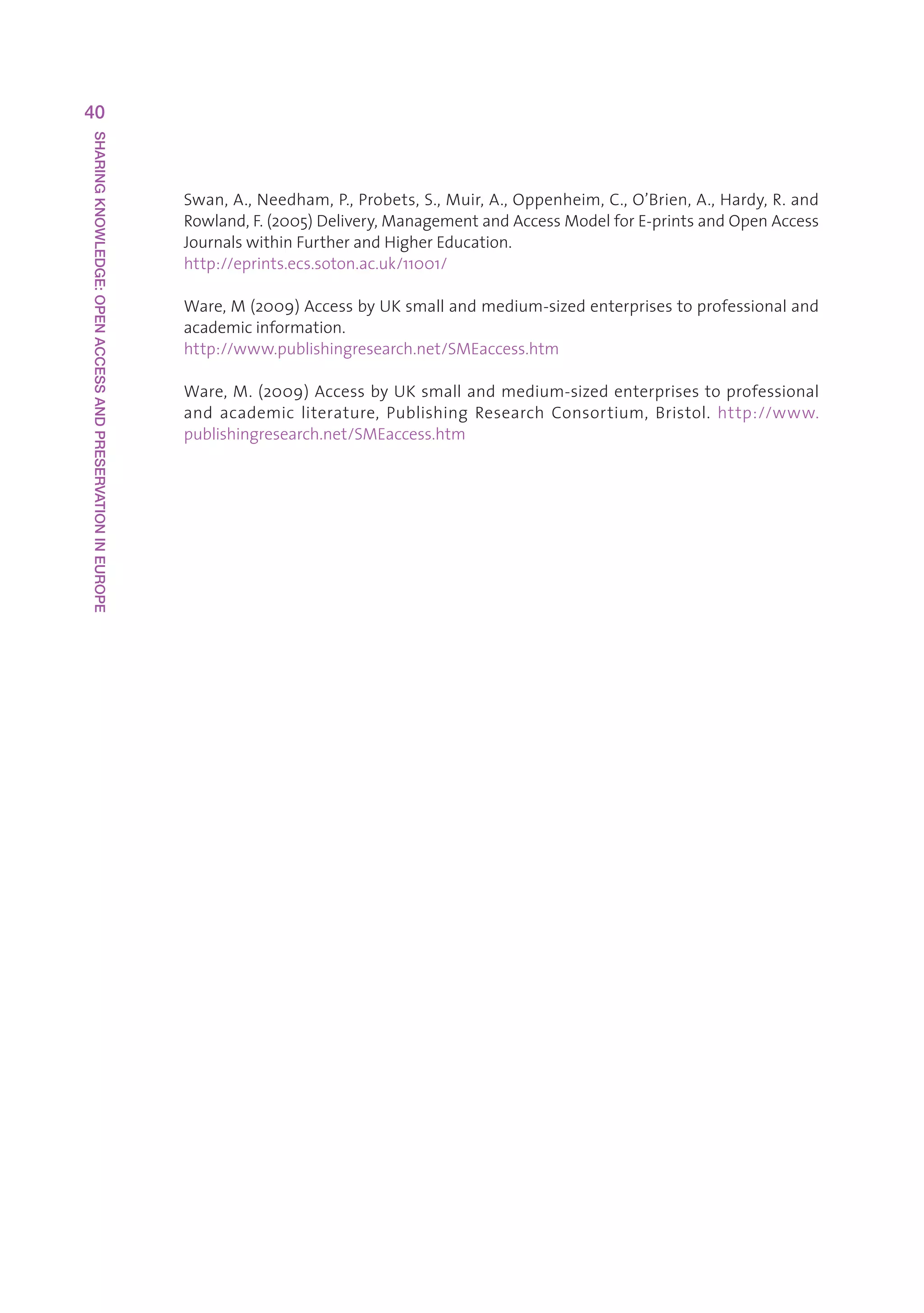
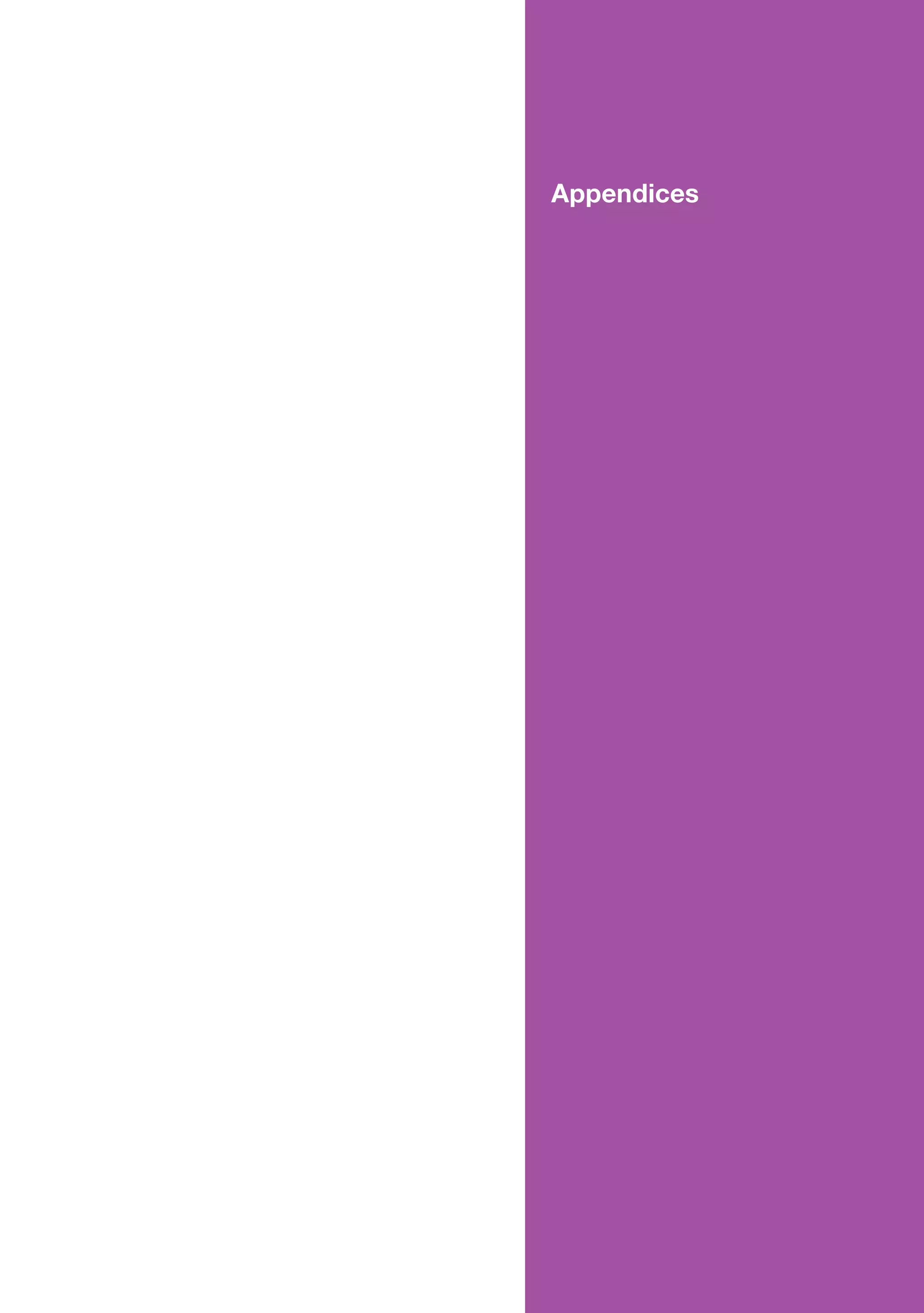
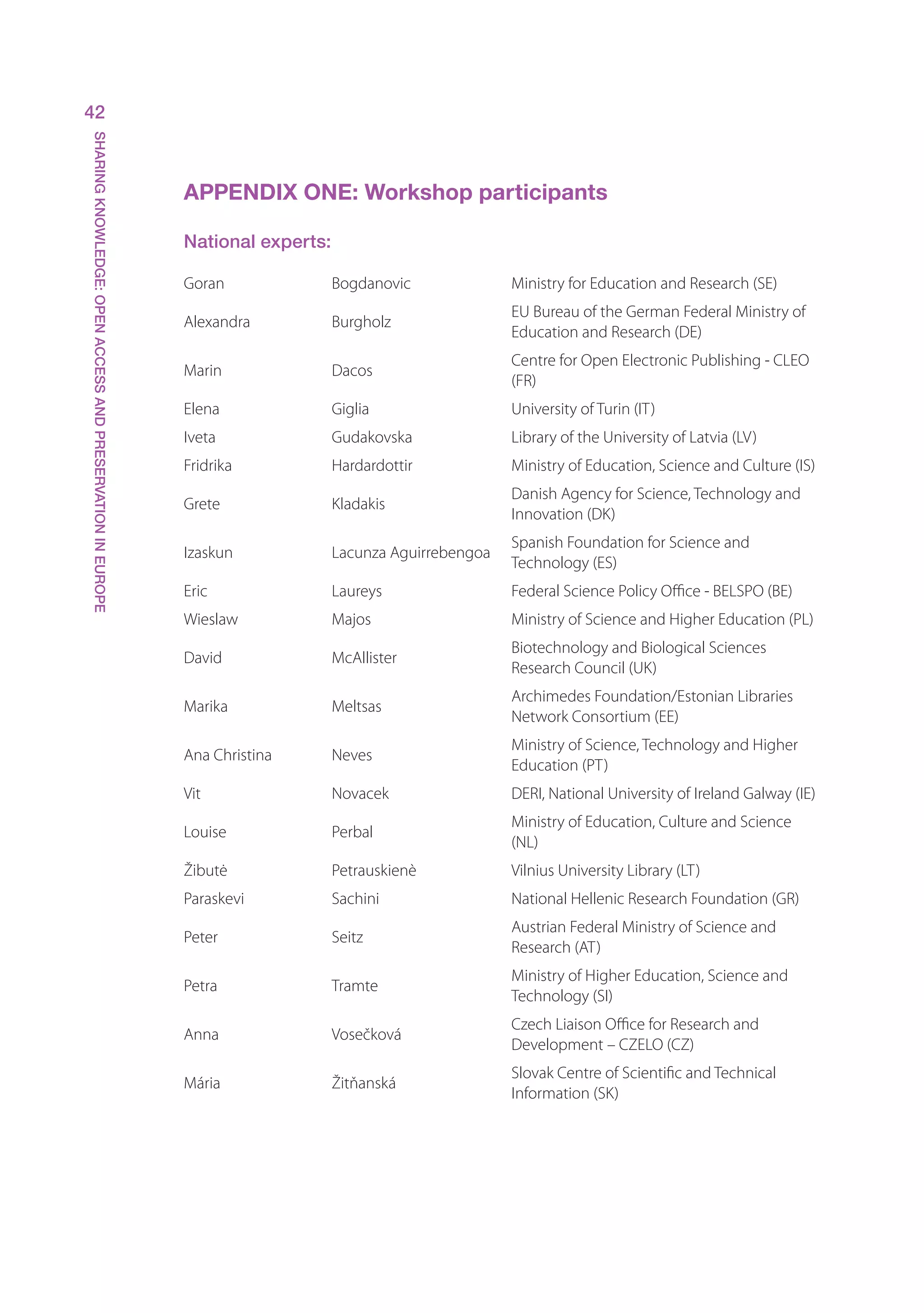
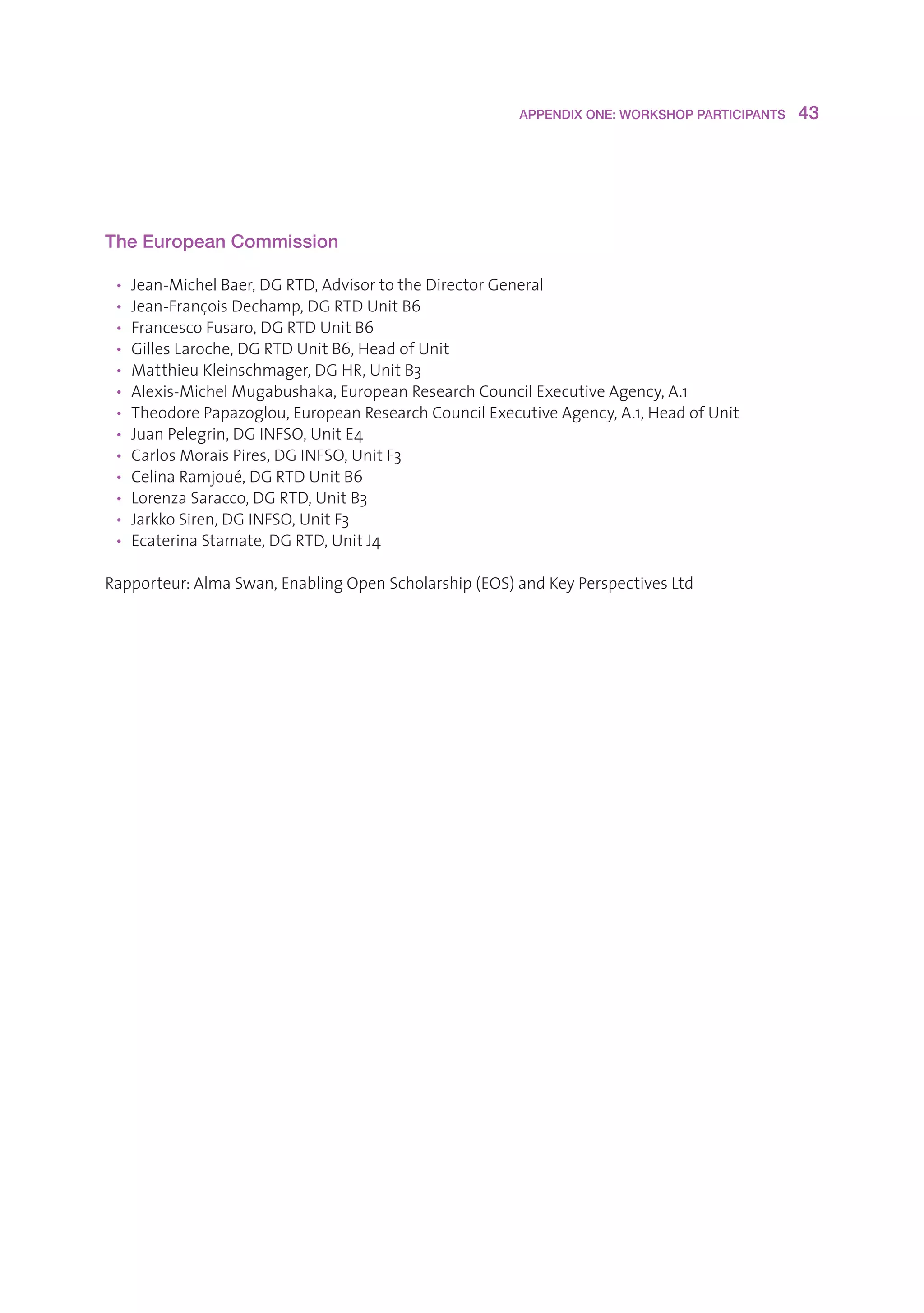
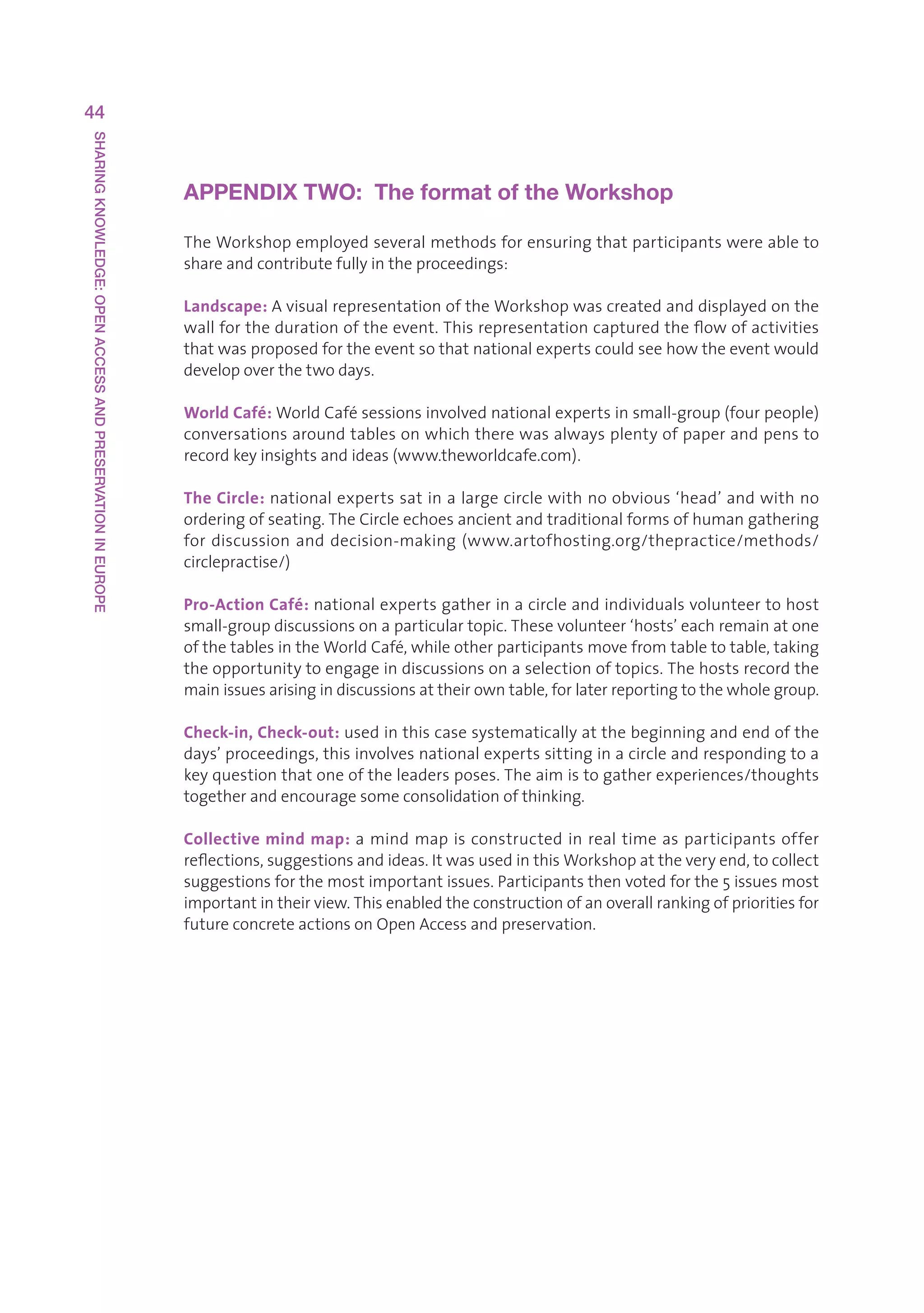
![APPENDIX THREE: OPEN ACCESS – THE EUROPEAN CONTEXT 45
APPENDIX THREE: Open Access – The european context
Thissectionwillprovideabriefoverviewofthebackgroundtotheworkshop,specifically:
• Thestudyonscientificinformationinthedigitalage,2006(EuropeanCommission,
2006)
• Theconferenceresultingfromthestudy,February2007 14
• TheCouncilConclusions,2007(CounciloftheEuropeanUnion,2007)
• TheCREST(Comité de la recherche scientifique et technique;inEnglish:Scientificand
TechnicalResearchCommittee)surveyofmembersin2008
• ThesessiononOpenAccessandpreservationintheERAconferenceonthefuture
ofscienceinEurope(2009) 15
Does scientific publishing work well?
Becausescientificpublishingmodelsderivefromtheprint-on-paperage,thepredominant
businessmodelissubscription-based.Mostuniversitylibrariescanaffordsubscriptionsto
onlyaproportionoftheseandlackofaccessremainsamajorimpedimenttotheworkof
mostresearchers,eveninresearch-intensive,developedcountries16.
Interestinimprovingthesharingofscientificinformationgrewmarkedlywhen,in2004,
theEuropeanCommissionembarkeduponanexaminationofthescientificpublishing
marketinEurope.In2006,theresultant‘Study on the economic and technical evolution of
the scientific markets in Europe’(EuropeanCommission,2006)waspublished.
Subsequentdebateonhowtoimproveaccessanddisseminationforscientificoutputs
engagedtheresearchcommunityandotherstakeholders,includingataconferenceonthe
topicinFebruary2007.Theresearchcommunitymadeitsvoiceheardatthistimeinthe
formof18,500signaturesgatheredinfourweeksforapetition,organisedbytheKnowledge
Exchangepartnership,callingfortheCommissiontoimplementarecommendationfrom
theStudythattheCommissionguaranteethatresultsfrompublicly-fundedresearchbe
madepublicly-accessibleshortlyafterpublication17.Fouryearslater,thepetitioncontinues
togathersignatures[thenumberofsignatoriesinearly2011isaround28,000].
TheoutcomeoftheoverallexercisewastheadoptionbytheCommissionofaCommunication
on Scientific Information in the Digital Age: Access, Dissemination and Preservation,apolicy
documentannouncingaseriesofmeasuresthatincludedexperimentingwithOpenAccess
14
E
uropeanCommissionpressrelease:Scientificinformationinthedigitalage:Ensuringcurrentand
futureaccessforresearchandinnovationhttp://europa.eu/rapid/pressReleasesAction.do?reference=
IP/07/190format=HTMLaged=0language=ENguiLanguage=en
15
h
ttp://ec.europa.eu/research/conferences/2009/era2009/index_en.htm
16
‘
…manyresearchersareencounteringdifficultiesingettingaccesstothecontenttheyneedandthat
thisishavingasignificantimpactontheirresearch.’Press Release: Overcoming barriers,Research
InformationNetwork,London(2009).Availablehttp://www.rin.ac.uk/our-work/using-and-accessing-
information-resources/overcoming-barriers-access-research-information.Seealsothefullreport:
http://www.rin.ac.uk/system/files/attachments/Sarah/Overcoming-barriers-report-Dec09_0.pdf
17
h
ttp://www.ec-petition.eu/](https://image.slidesharecdn.com/ki3111187ennwebupdatedforemaildeletetheotherone-111129025024-phpapp01/75/Knowledge-sharing-OA-and-preservation-in-Europe-47-2048.jpg)
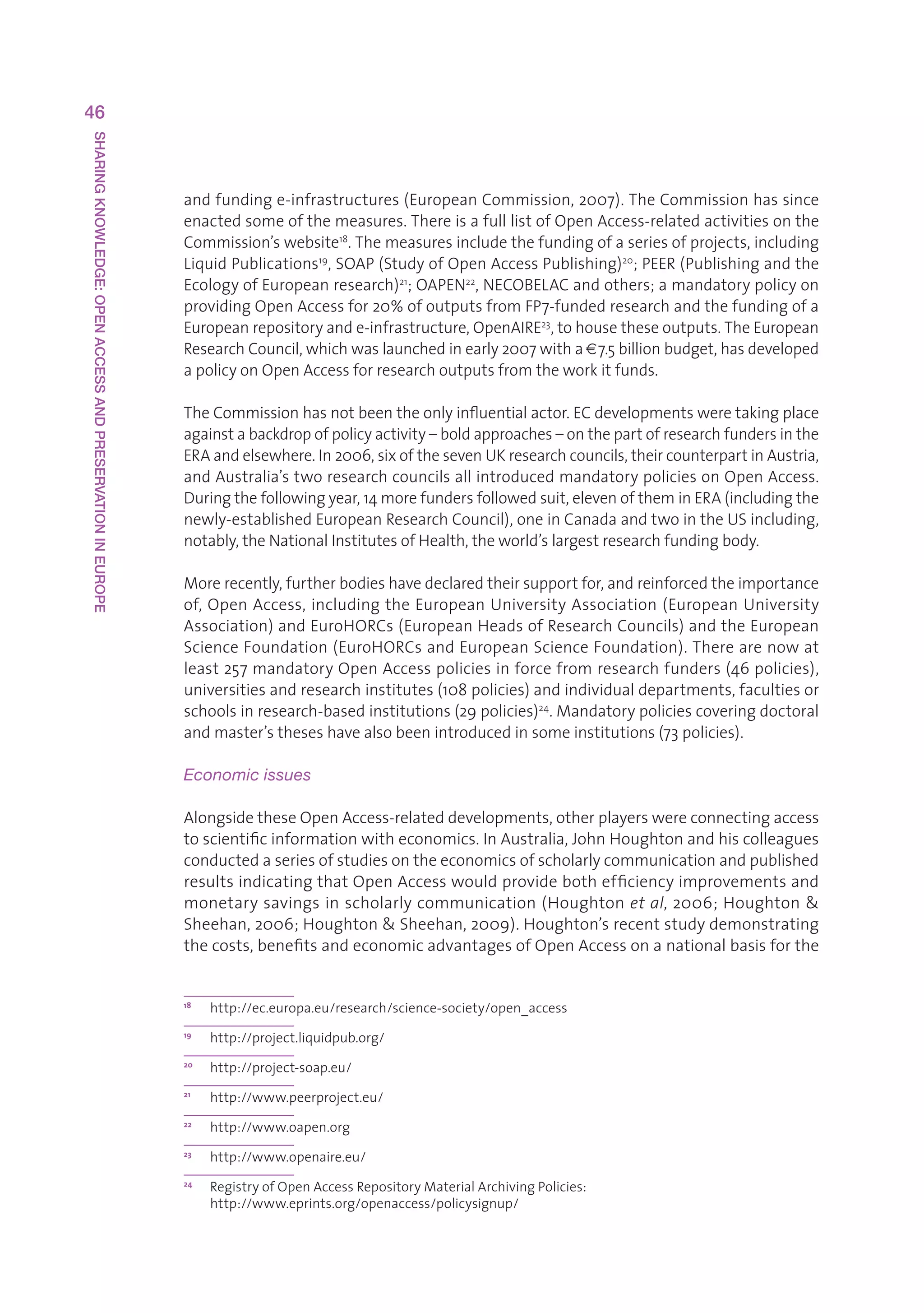
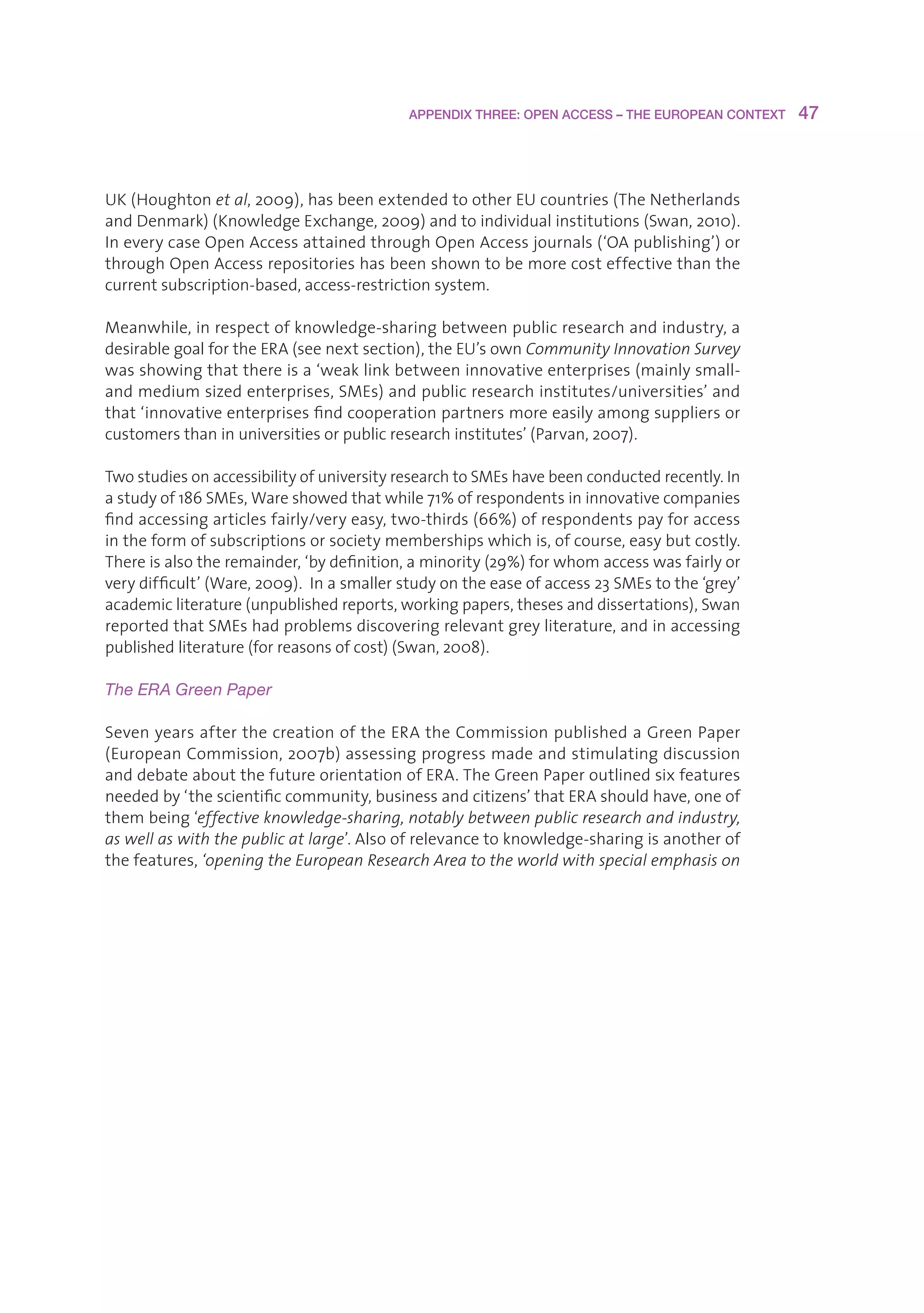
![48
SHARING KNOWLEDGE: OPEN ACCESS AND PRESERVATION IN EUROPE
neighbouring countries and a strong commitment to addressing the global challenges with
Europe’s partners’25.
TwoofthequestionsthattheGreenPaperposedinordertostimulateknowledge-sharing
werethese:
• IsthereaneedforEU-levelpoliciesandpracticestoimproveandensureOpen
Accesstoanddisseminationofrawdataandpeer-reviewedpublicationsfrom
publiclyfundedresearchresults?
• WhatshouldconstituteaEuropeanFrameworkforknowledgesharingbetween
researchinstitutionsandindustrybasedonidentifiedgoodpracticeandmodels?
ThesearecorequestionsthatresurfacedintheWorkshop.Headlinefindingsfromthe
responsestotheGreenPaperthatshowedthat68%ofrespondentsthinkthatraw
datafrompublicly-fundedresearchshouldbemademorereadilyaccessible,theseand
moresuggestingthatEU-levelcollectionsarethepreferredlocation.Sixty-fivepercent
ofthetotalrespondentpopulationthinksthatpeer-reviewedpublicationsresulting
frompublicly-fundedresearchshouldbeaccessiblewithoutcharge(includedinthis
respondentgrouparepublishers,71%ofwhomdisagreewiththisstatement).And65%
ofrespondents(presumablymostlythesame65%)alsobelievethatthesepublications
shouldbeavailablewithoutchargeassoonastheyarepublished.
Council Conclusions
Latein2007,theCounciloftheEuropeanUnionadopteditsConclusions on Scientific
Information in the Digital Age: Access, Dissemination and Preservation(Councilofthe
EuropeanUnion,2007).ThisdocumentcalleduponMemberStatestoreinforce national
strategies and structures for access to and dissemination of scientific information,and
pledgedtoenhance the co-ordination between Member States on access and dissemination
policies and practicesandtoensure the long term preservation of scientific information –
including publications and data – and pay due attention to scientific information in national
preservation strategies.
25
R
elevant statements contained in the Green paper in reference to the topic of Knowledge
Sharing are: ‘State-of-the-art knowledge is crucial for successful research in any scientific
discipline. Reliable, affordable and permanent access to, and widespread dissemination of,
scientific research results should therefore become defining principles for Europe’s research
landscape.Thedigitalerahasopenedupnumerouspossibilitiesinthisrespect.Opportunities
forprogresscanbeseen,notablyinthedevelopmentofonlinelibraries,repositoriesofscientific
informationanddatabasesofpublicationsandpubliclyfundedresearchresults.Theseshould
be integrated at European level and interlinked with similar databases in third countries. In
particular,thesystembywhichscientificinformationispublishedispivotalforitsvalidation
anddissemination,andthushasamajorimpactontheexcellenceofEuropeanresearch.Europe
should stimulate the development of a “continuum” of accessible and interlinked scientific
informationfromrawdatatopublications,withinandacrossdifferentcommunitiesandcountries.'
‘Effectiveknowledgesharing[…]shouldconsistof:openandeasyaccesstothepublicknowledgebase;
asimpleandharmonisedregimeforIntellectualPropertyRights,includingacost-efficientpatenting
systemandsharedprinciplesforknowledgetransferandcooperationbetweenpublicresearchand
industry;innovativecommunicationchannelstogivethepublicatlargeaccesstoscientificknowledge,
themeanstodiscussresearchagendasandthecuriositytolearnmoreaboutscience.’](https://image.slidesharecdn.com/ki3111187ennwebupdatedforemaildeletetheotherone-111129025024-phpapp01/75/Knowledge-sharing-OA-and-preservation-in-Europe-50-2048.jpg)
![APPENDIX THREE: OPEN ACCESS – THE EUROPEAN CONTEXT 49
TheEuropeanCommissionitselfwasinvitedtomonitorgoodpracticesandsupport
MemberStatepolicyco-ordination.Specifically,itwasinvitedtoimplement the measures
announced in the Communication on ‘scientific information in the digital age: access,
dissemination and preservation’ and in particular to:
- experiment with Open Access to scientific publications resulting from projects funded
by the EU Research Framework Programmes
- support experiments and infrastructures with a cross-border added-value for access
to and preservation of scientific information
- contribute to improved policy co-ordination between Member States and to a
constructive debate between stakeholders
The Commission responded in part by including a session on Open Access and
Preservation in the ERA conference ‘Working Together to Strengthen Science in
Europe’conferenceinOctober200926.Thesessionresultedinasetofconclusionsand
recommendationswhichidentifiedthreemainissues:theneedtoprovideresearch
outputs(articles,books,datasetsetc)inanopenlyaccessibleandeasilyre-usableway;
theneedtoprovideanintegratedsystemofsciencecommunication–anecosystemof
infrastructures–thatensurestheoptimalfunctioningofthesystem;andtheweaklink
betweenthebasicresearchsectorandinnovativeindustriesinERA.
The CREST27 questionnaire (Comité de la recherche scientifique et technique; in
English: Scientific and Technical Research Committee)
AquestionnairewassentouttoMemberStatesviatheScientificandTechnicalResearch
Committee(CREST)inDecember2008andresponsescollectedinthefirstpartof2009.
Twenty-fiveresponseswerereceivedfromCRESTmembers(EUMemberStates)andfive
fromCRESTobservers.Aselectedfewofthesummarisedfindingsfromtheresponses
indicatethegeneralstateofaffairsreported:
• Withrespecttonational strategies on access and dissemination,theCommission
concludesthatwhile‘the growing number of national initiatives in this field
shows a clear and encouraging move towards the development of policies in
these areas …there are very few of the nationally coordinated strategies or
policies called for in the 2007 Council Conclusions’.
• Oncoordination activities on access and dissemination,theCommissionfinds
that‘while existing declarations and initiatives form a solid basis to build on,
explicit common national funding body principles, for example on Open Access,
are still missing’.Moreover,despitesomeadvances,‘transparency regarding big
deals [between publishers and libraries] is still lacking’.Thereisbetternewson
repositoriesinEurope,though,withthefindingthat‘significant coordination
initiatives are underway regarding interoperability of repositories’.
26
http://ec.europa.eu/research/conferences/2009/era2009/index_en.htm
27
renamedERAC(EuropeanResearchAreaCommittee)in2010](https://image.slidesharecdn.com/ki3111187ennwebupdatedforemaildeletetheotherone-111129025024-phpapp01/75/Knowledge-sharing-OA-and-preservation-in-Europe-51-2048.jpg)
